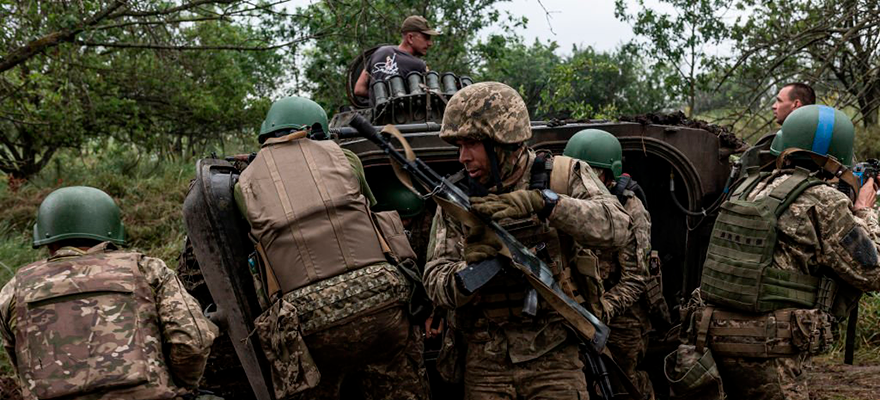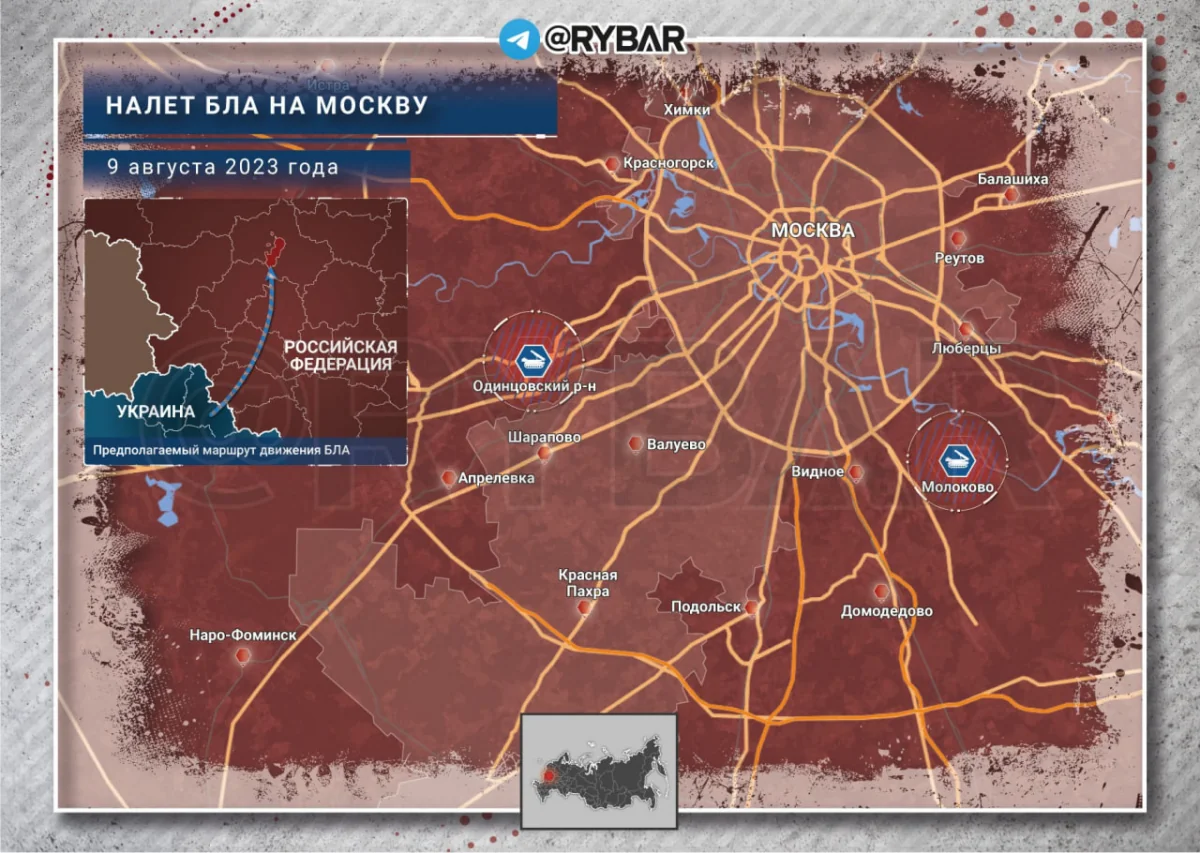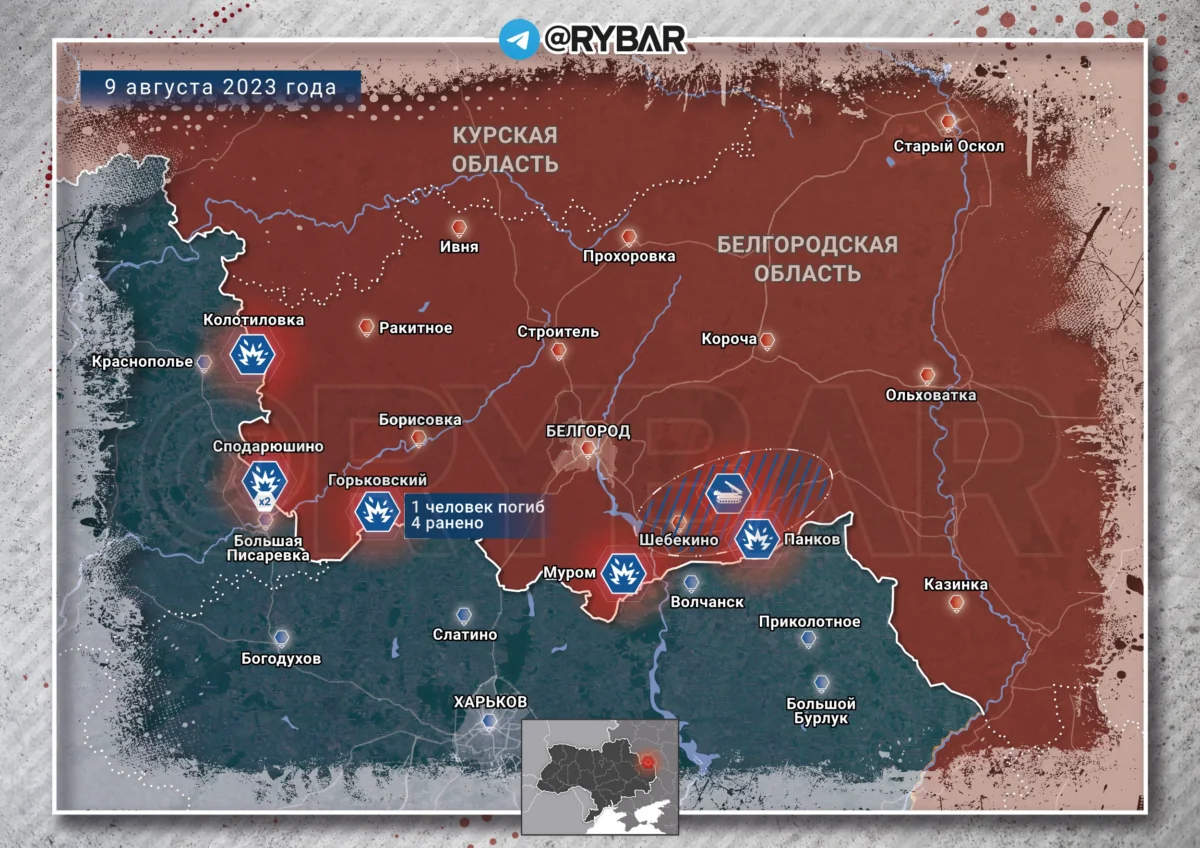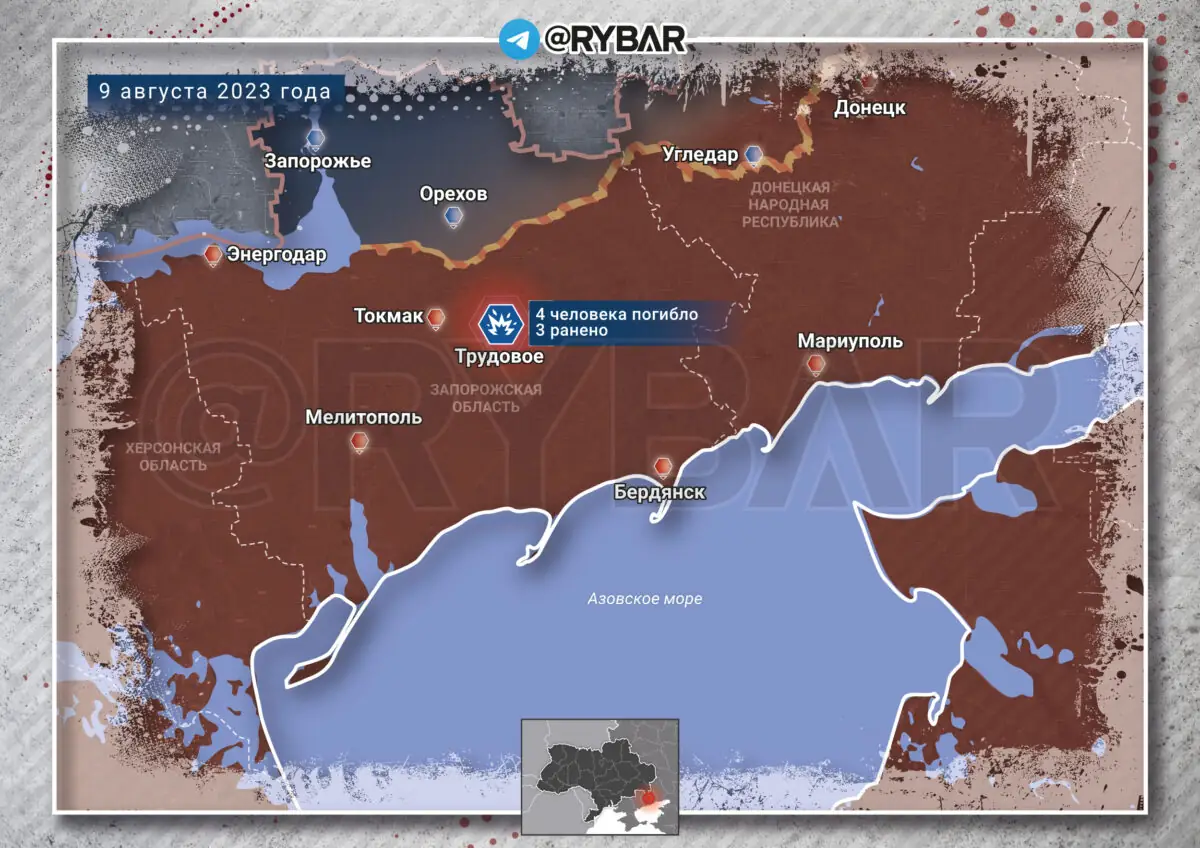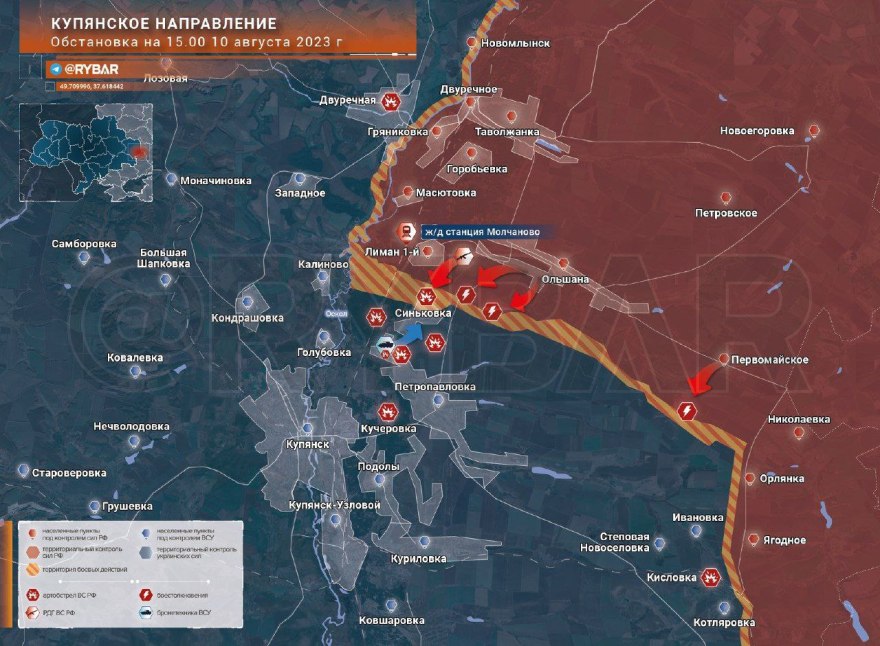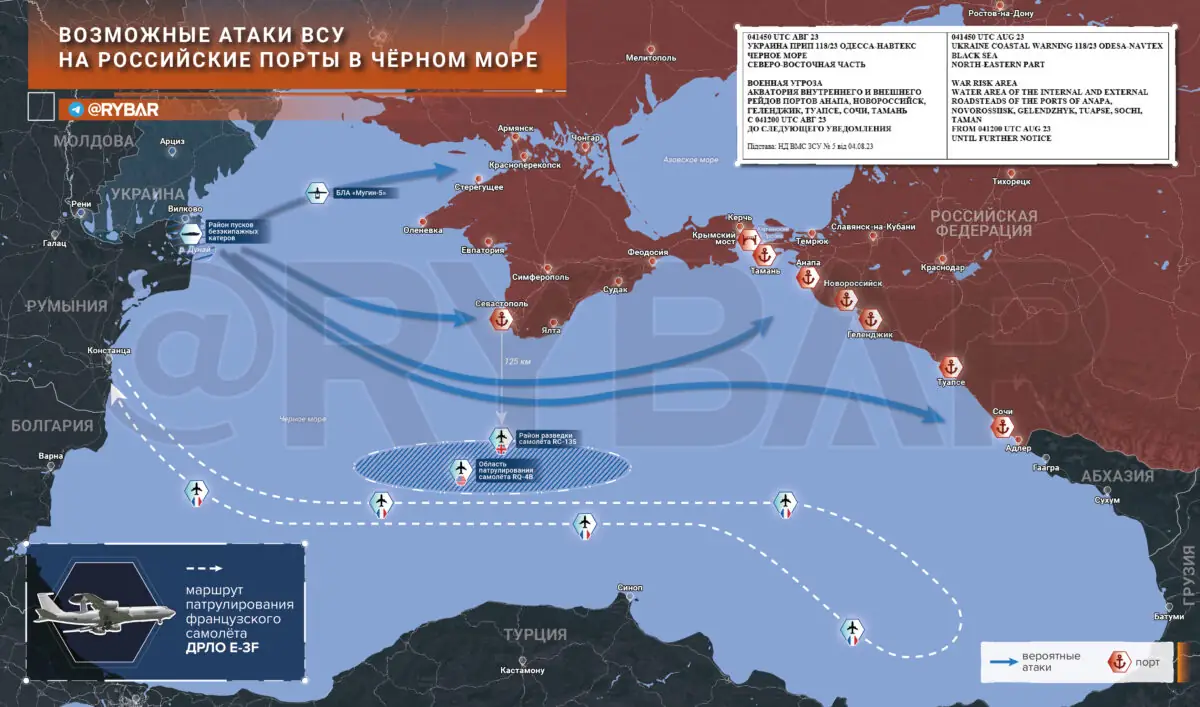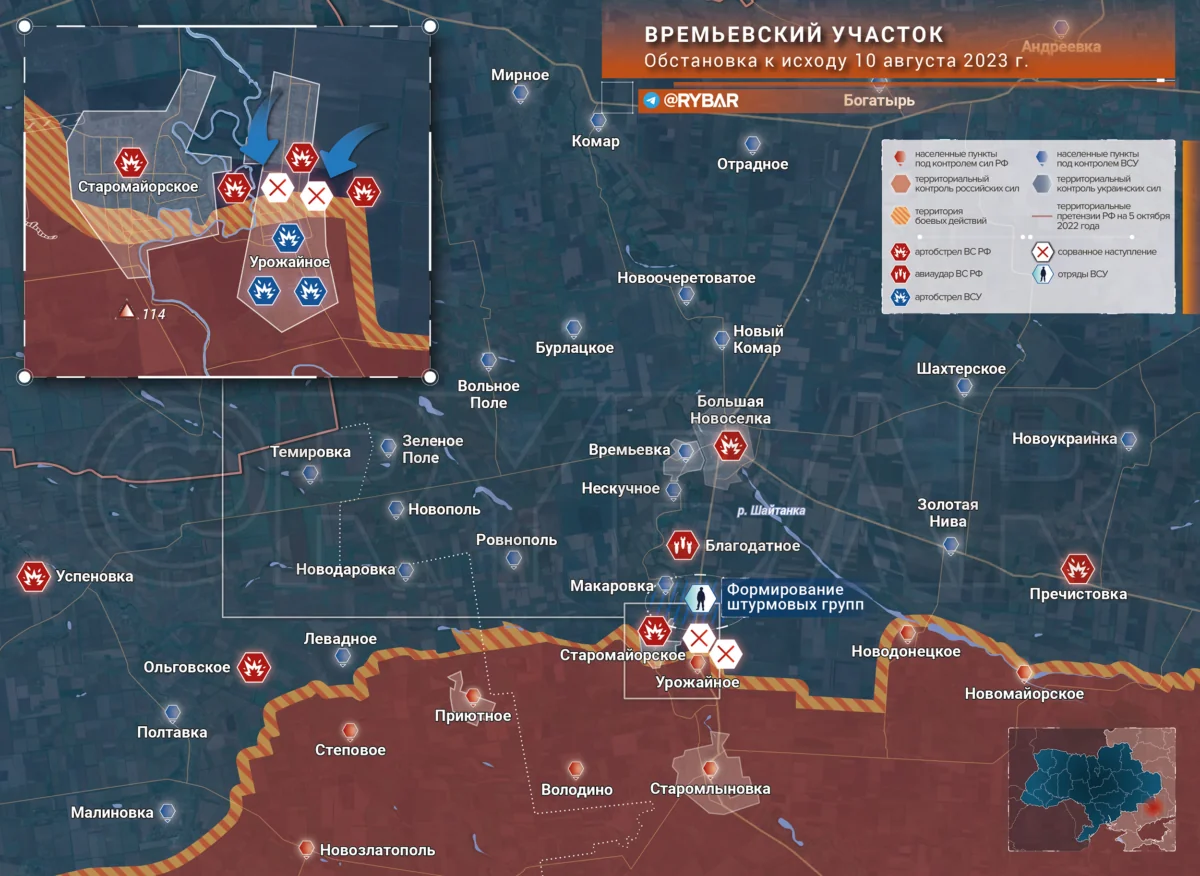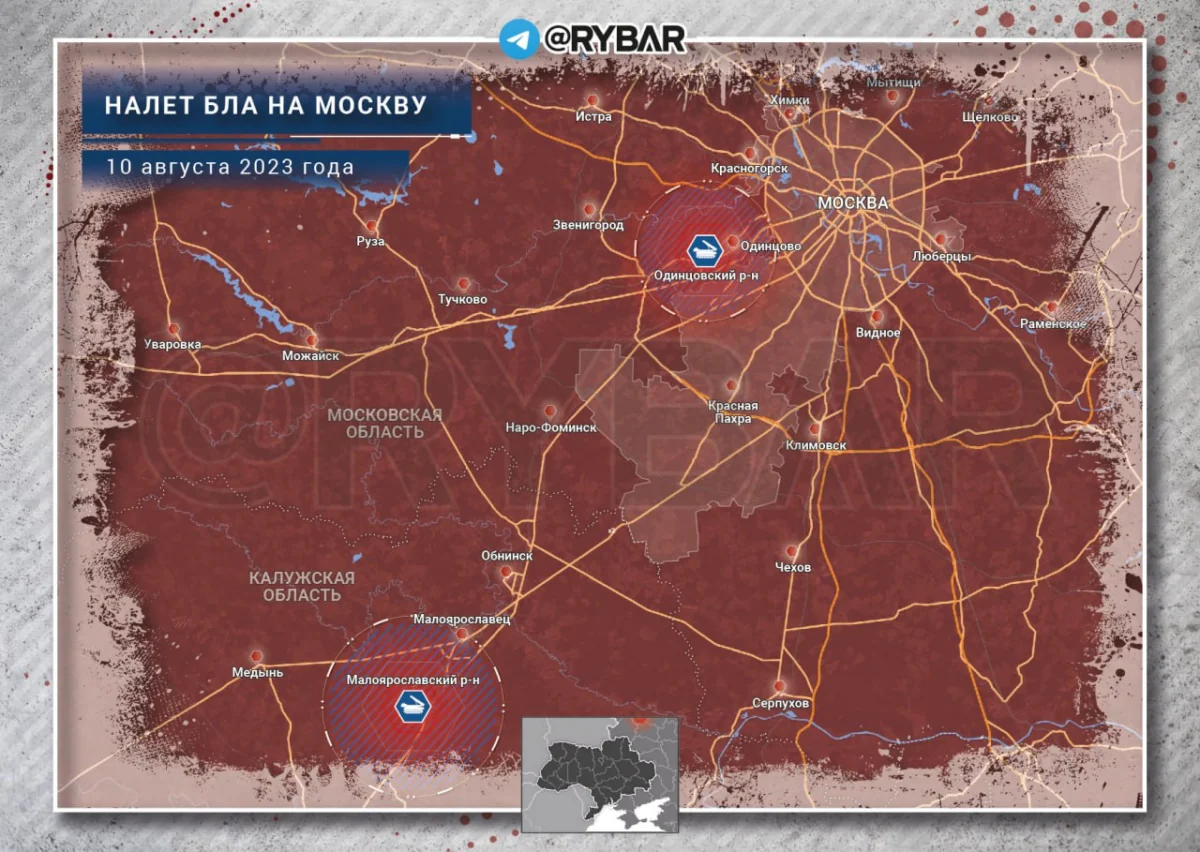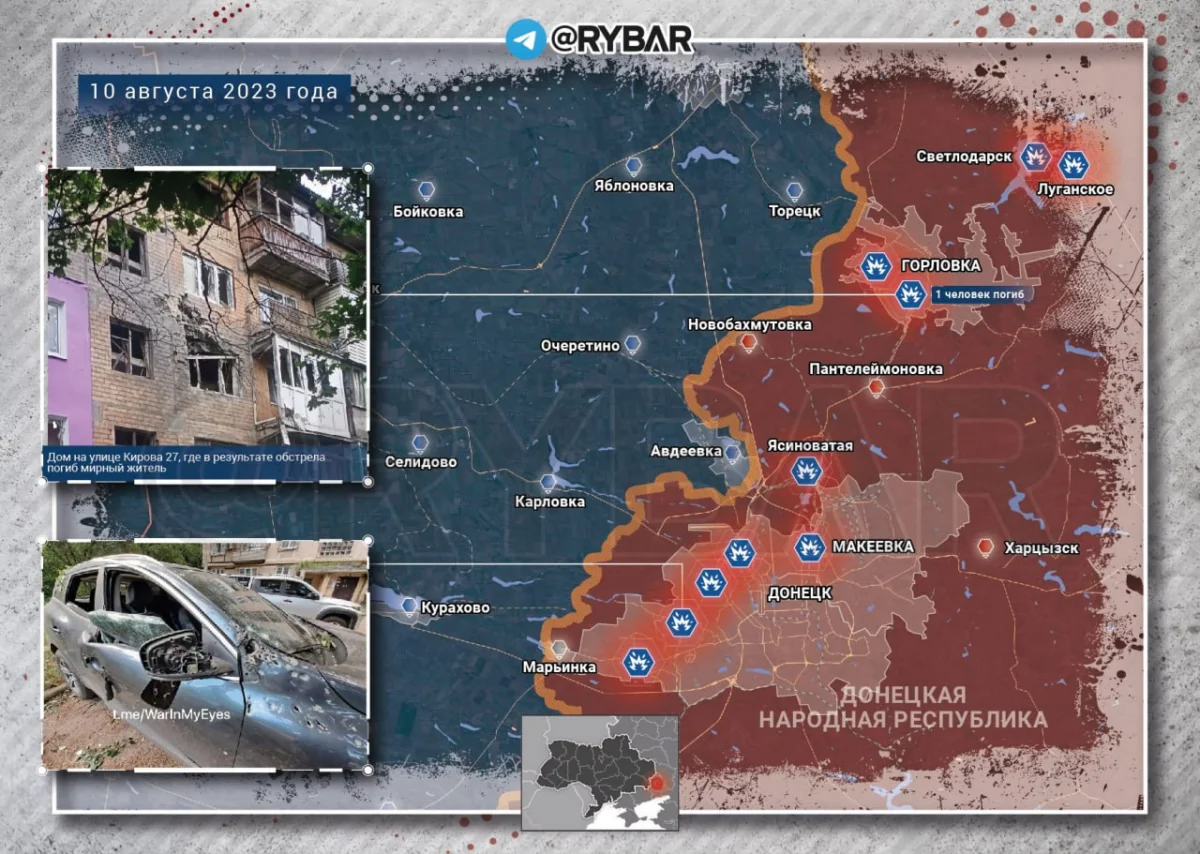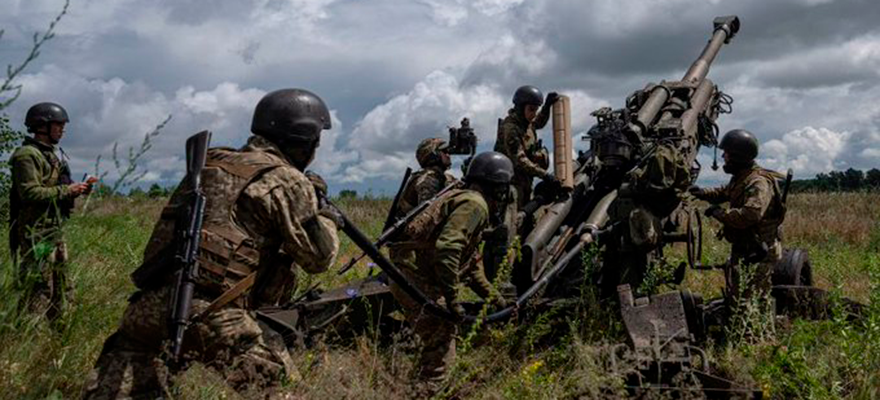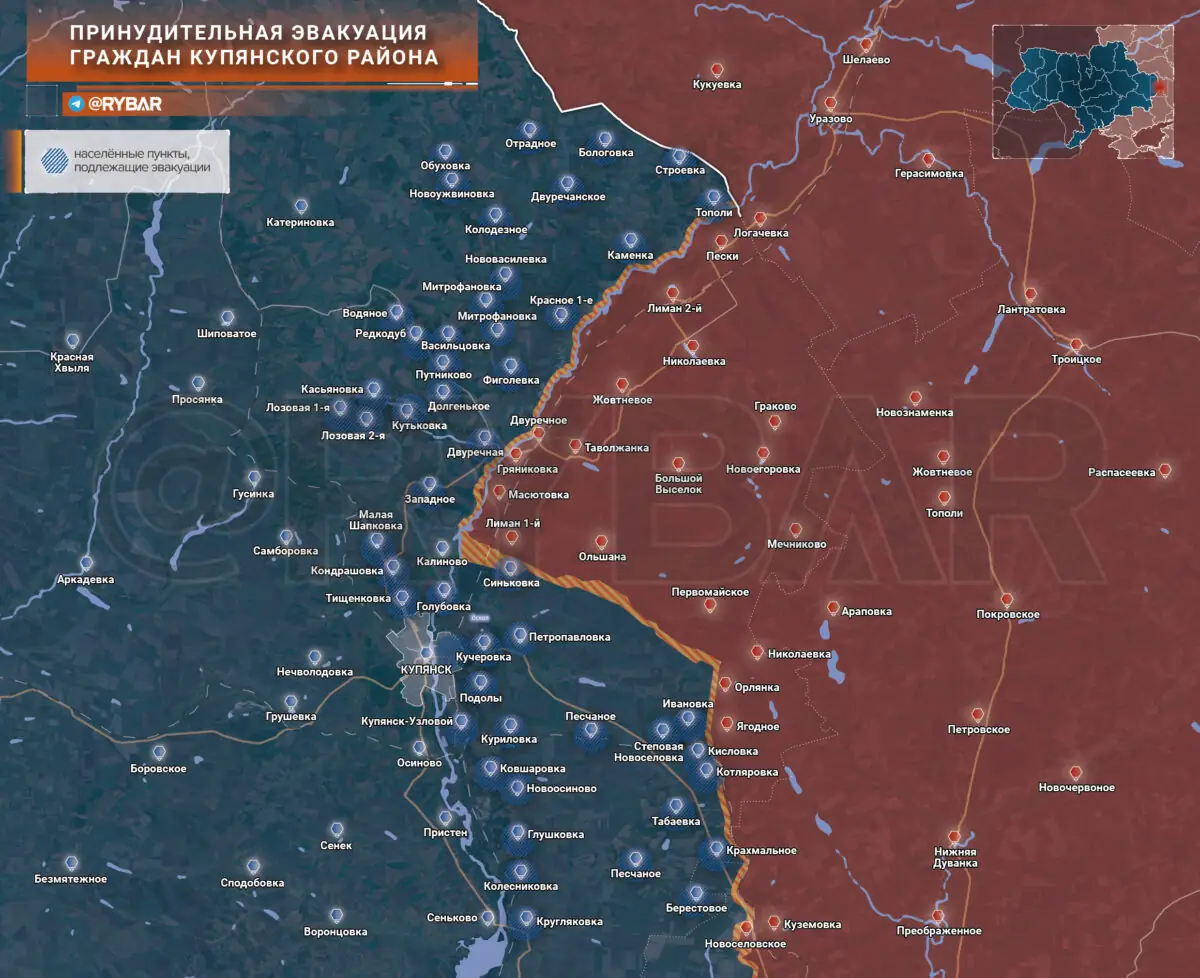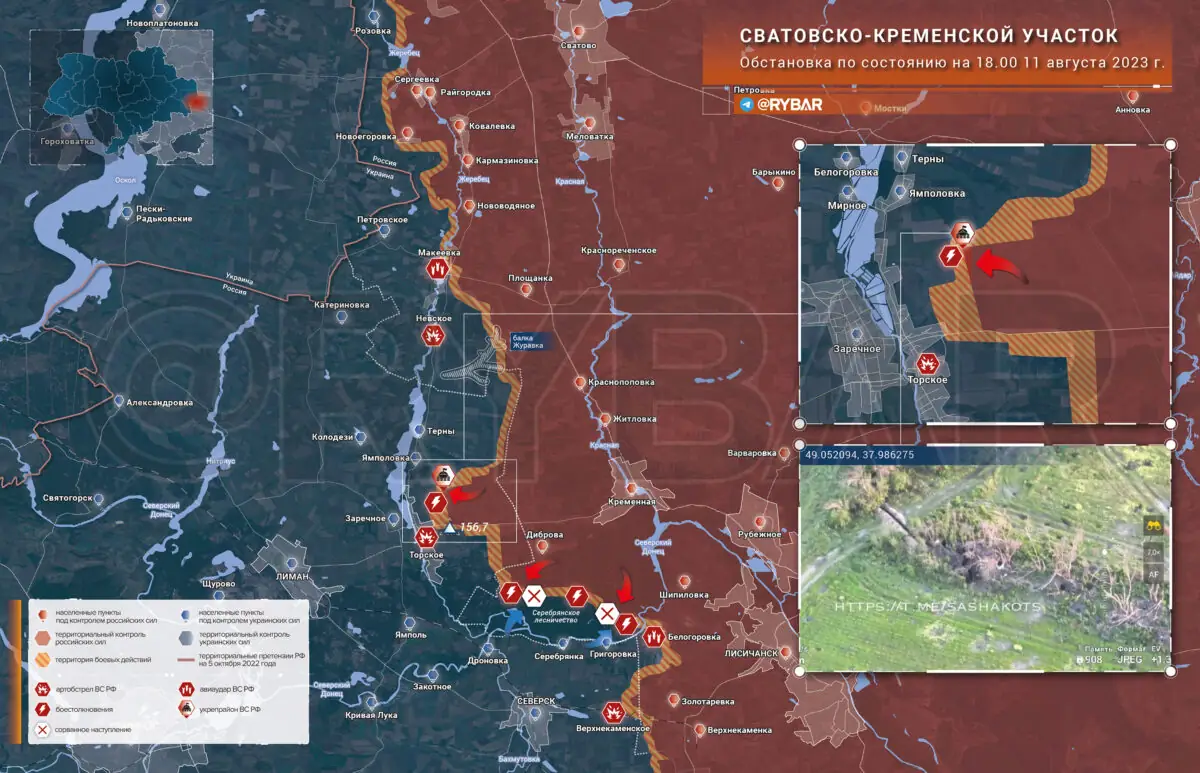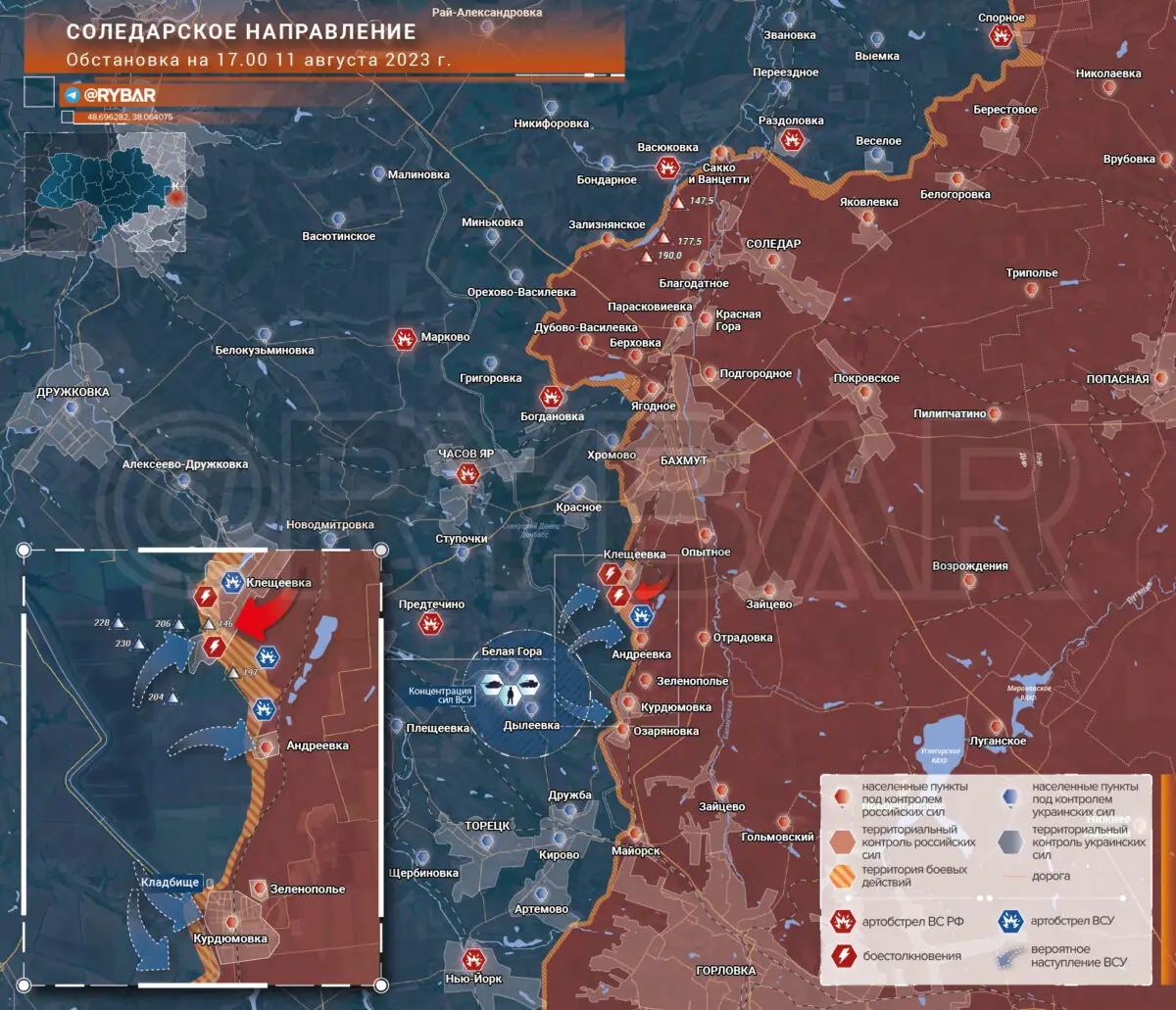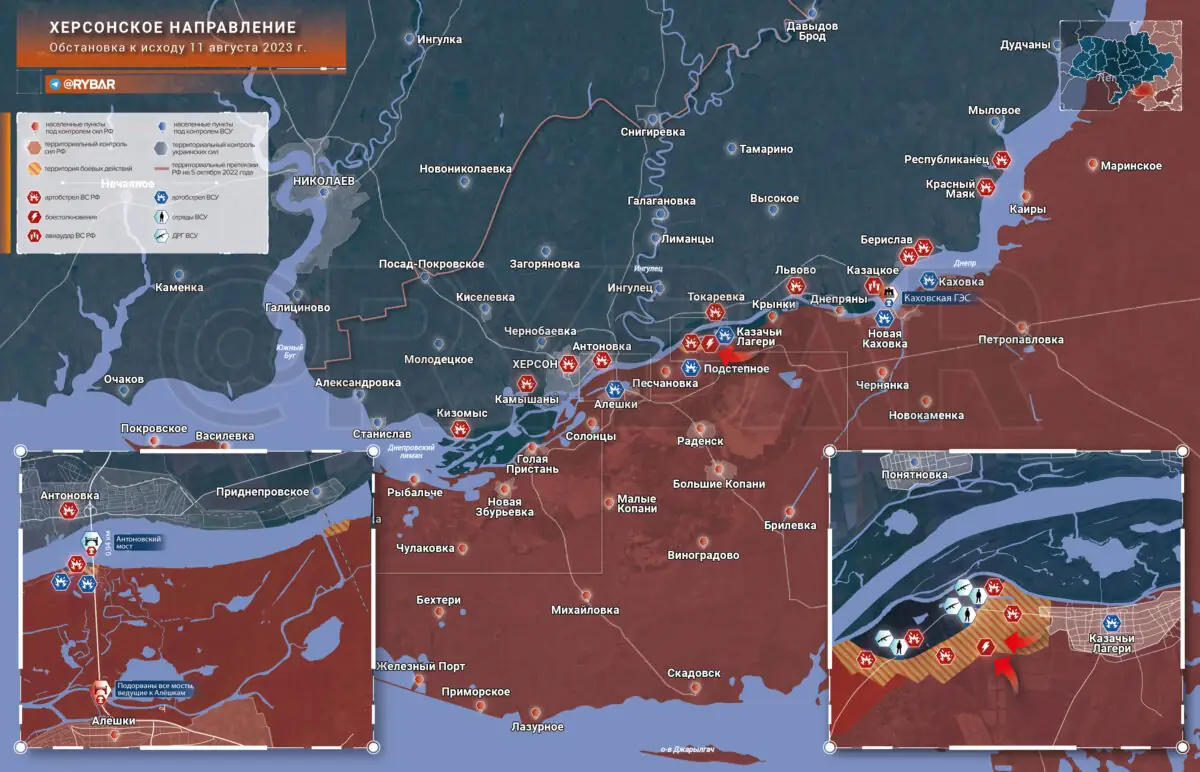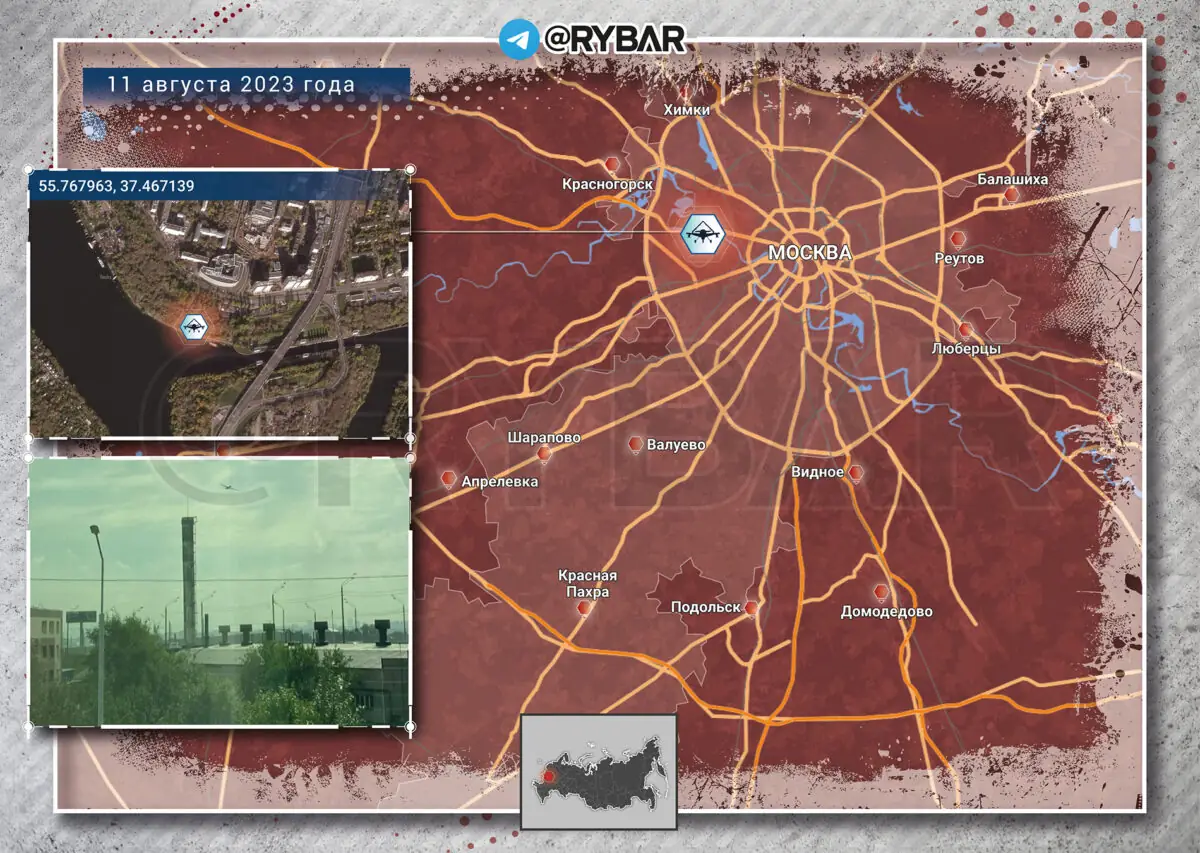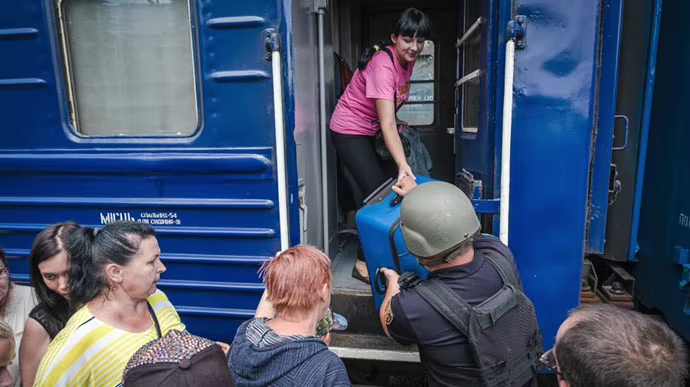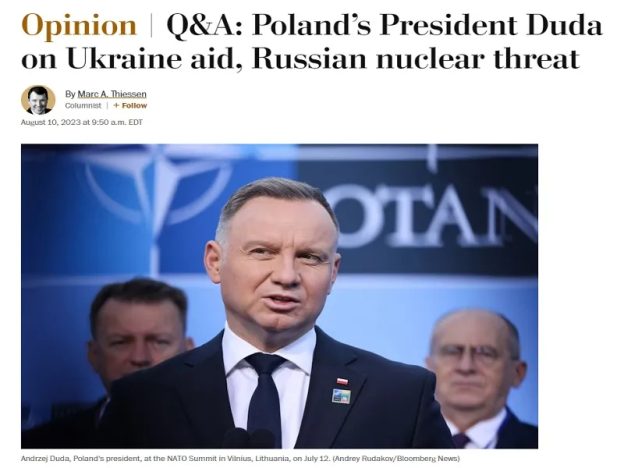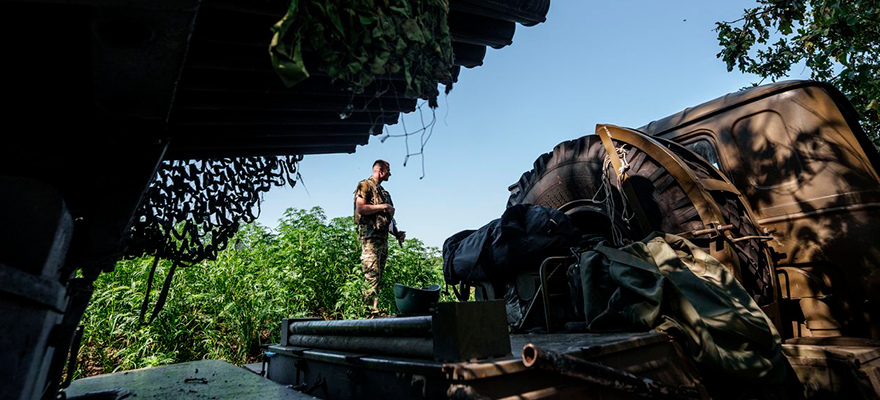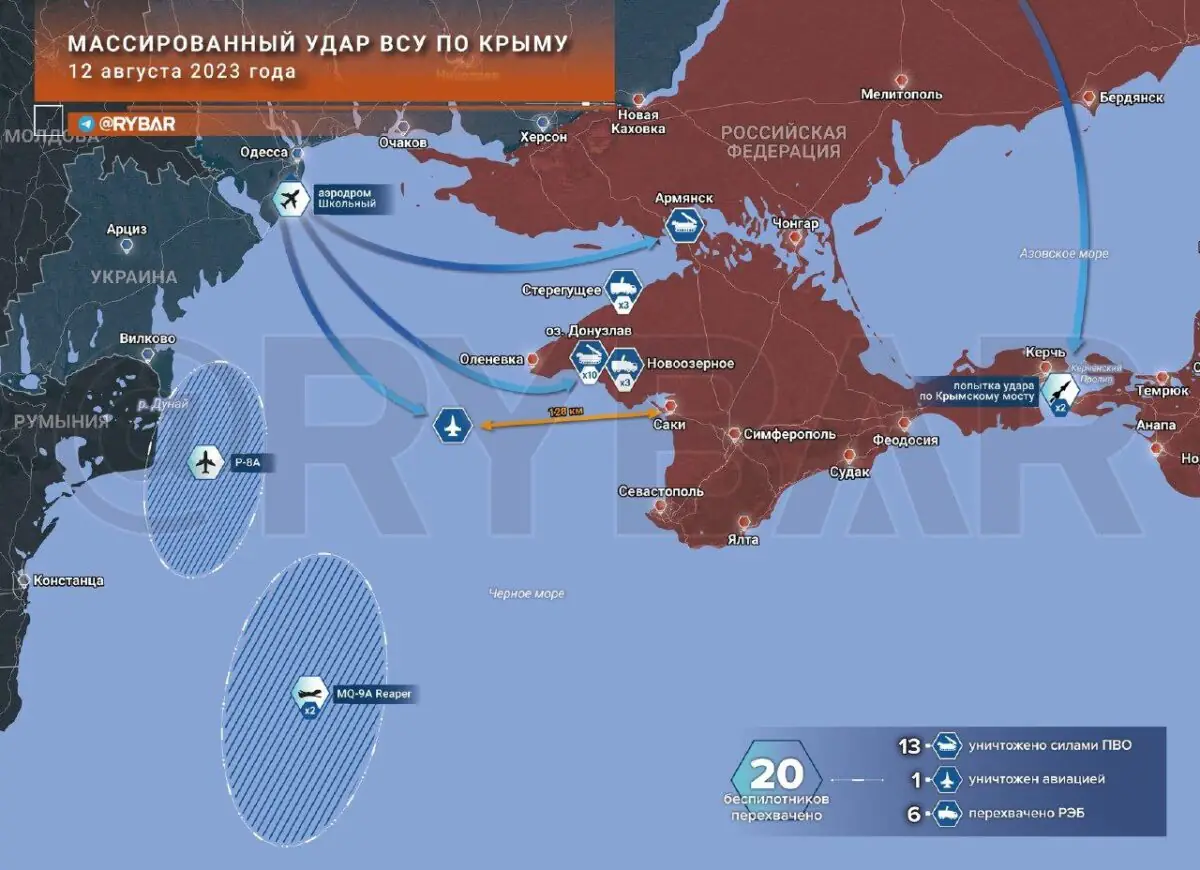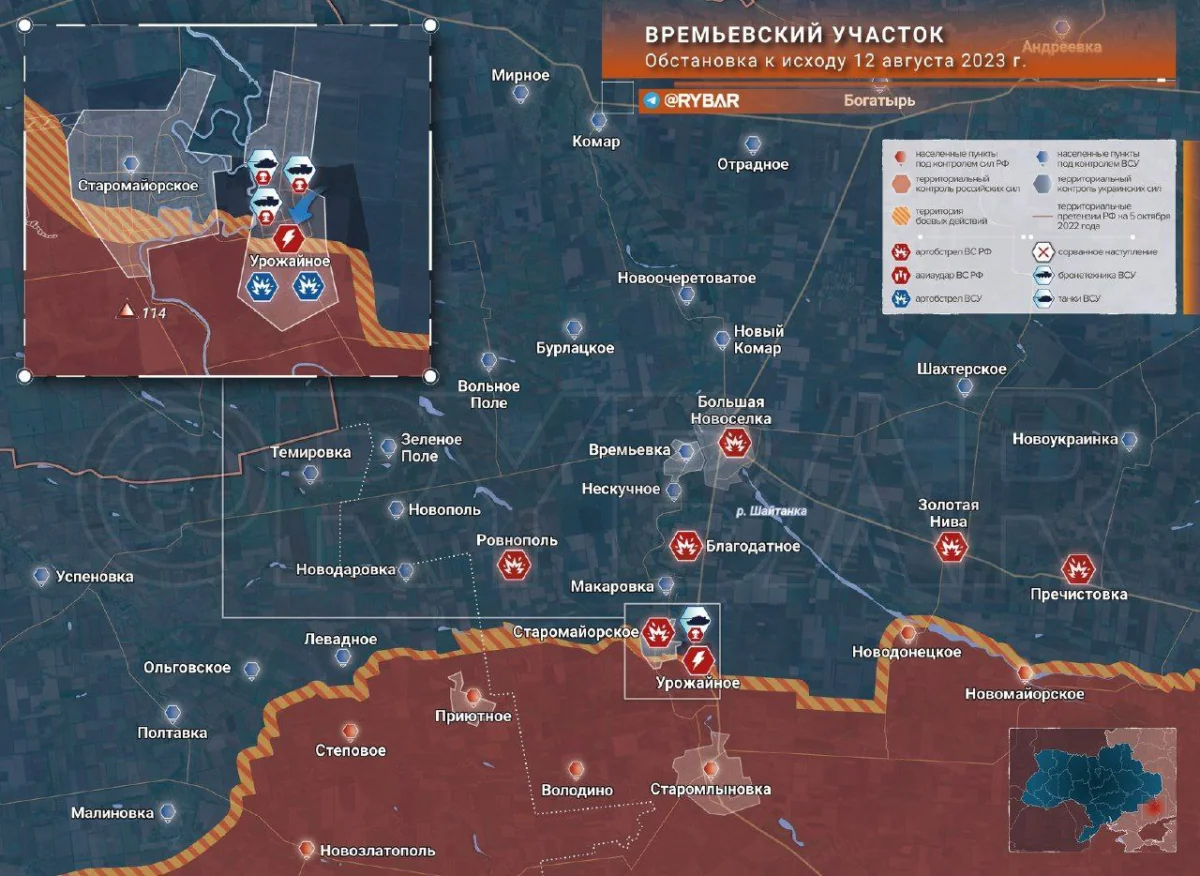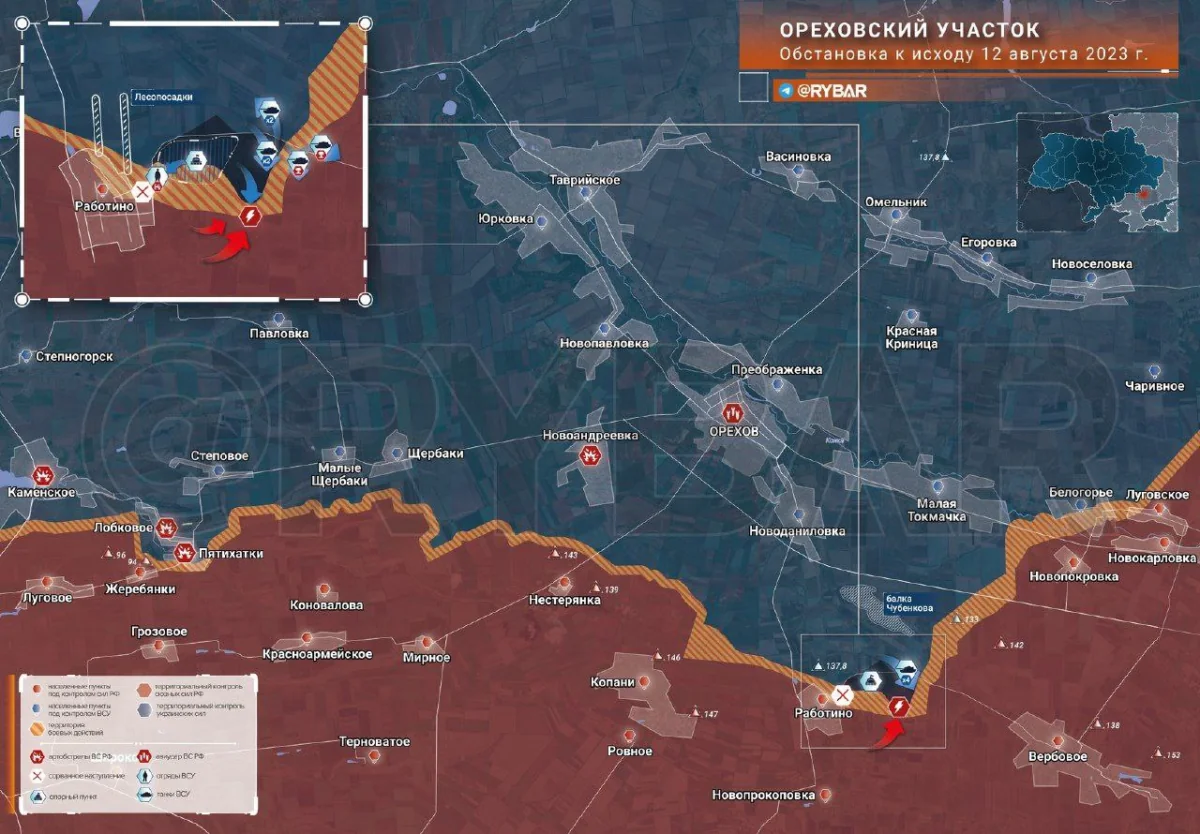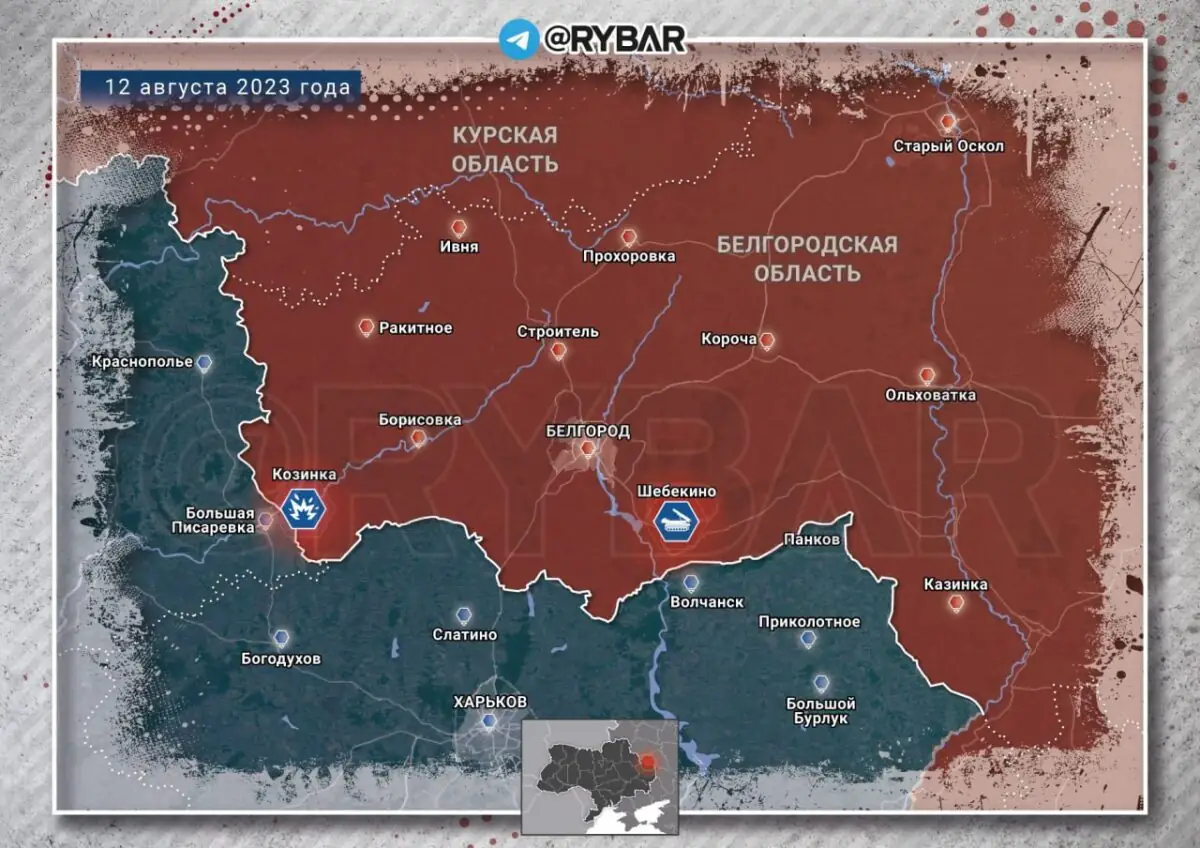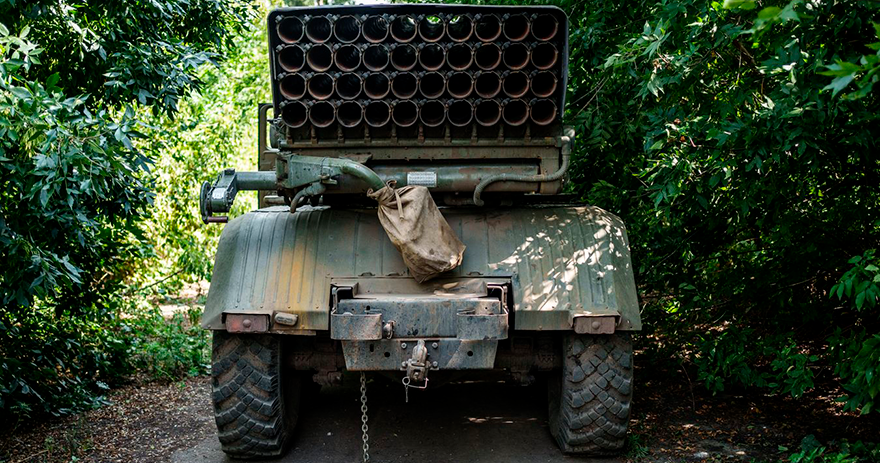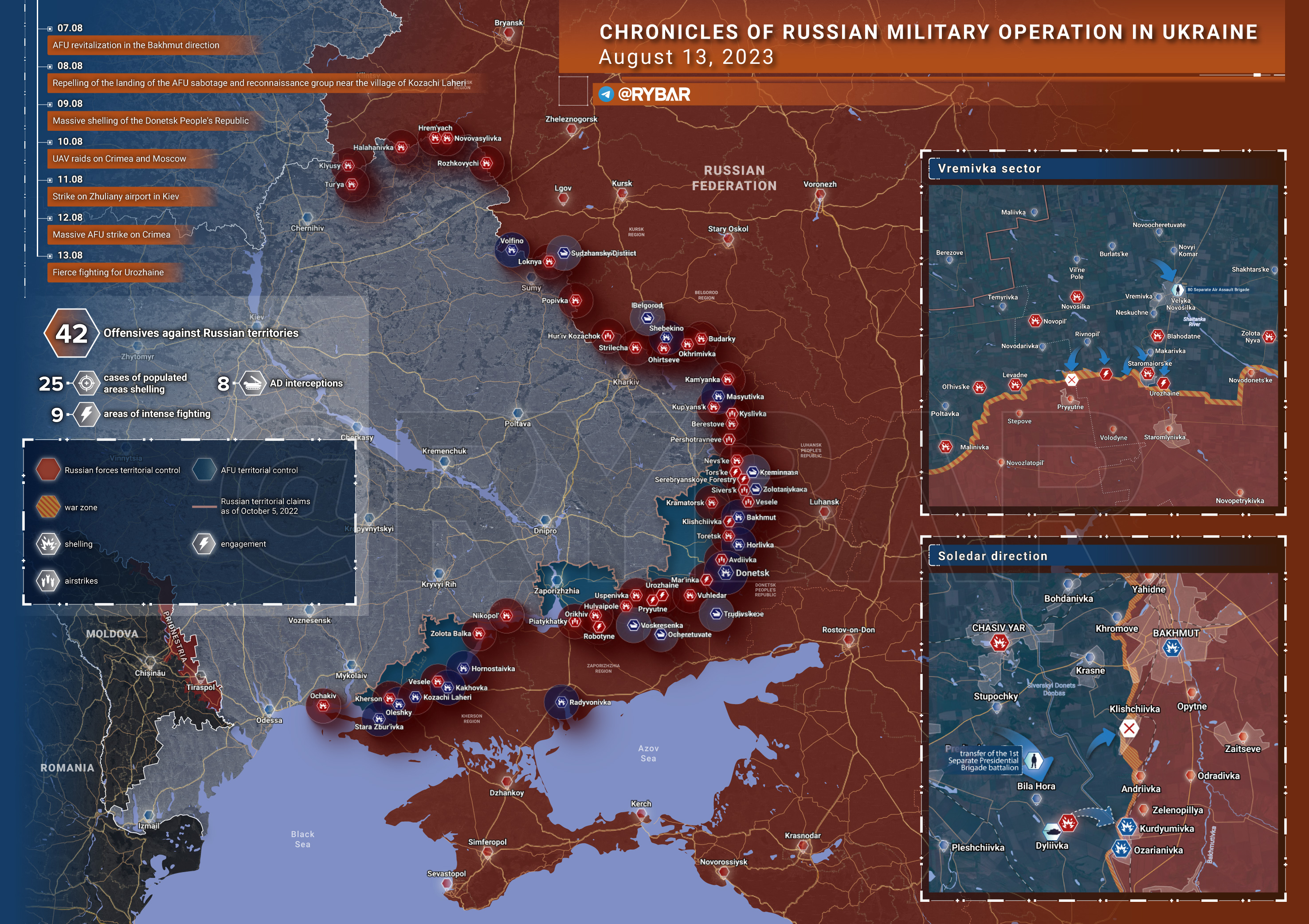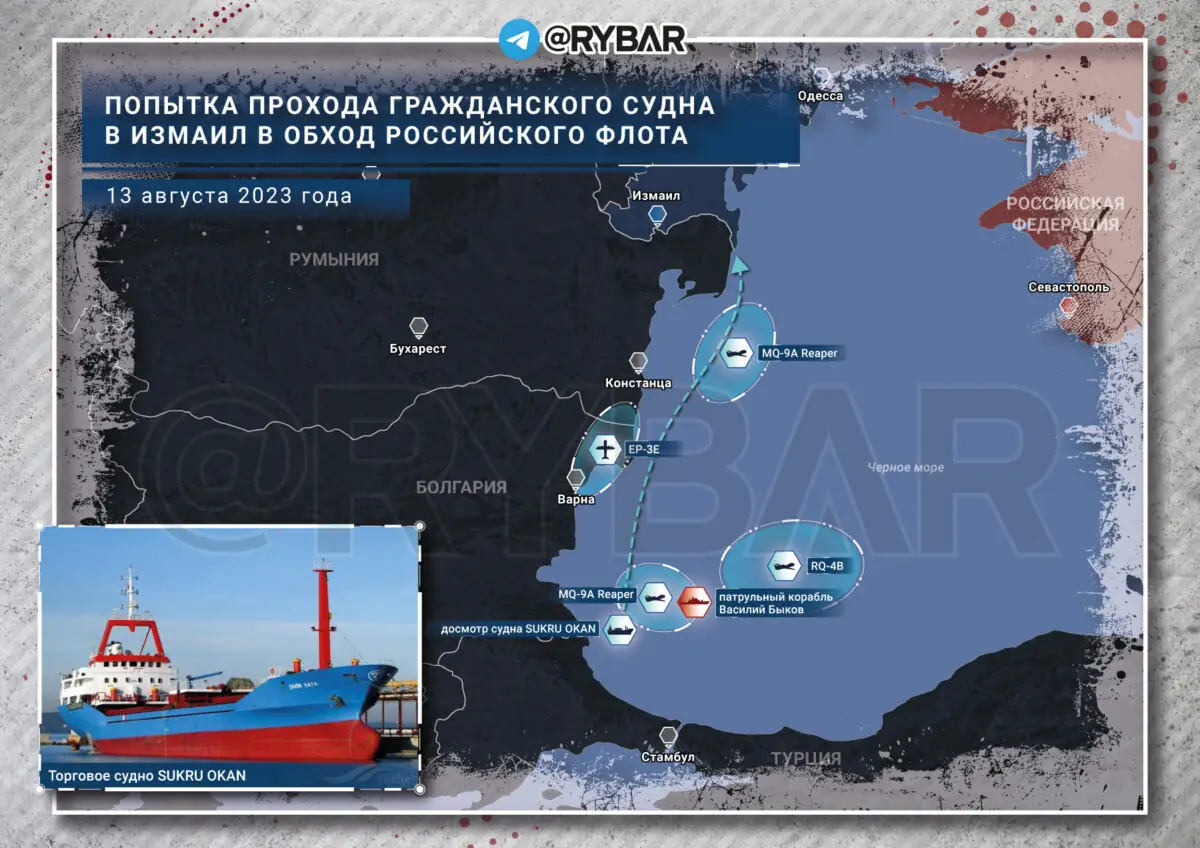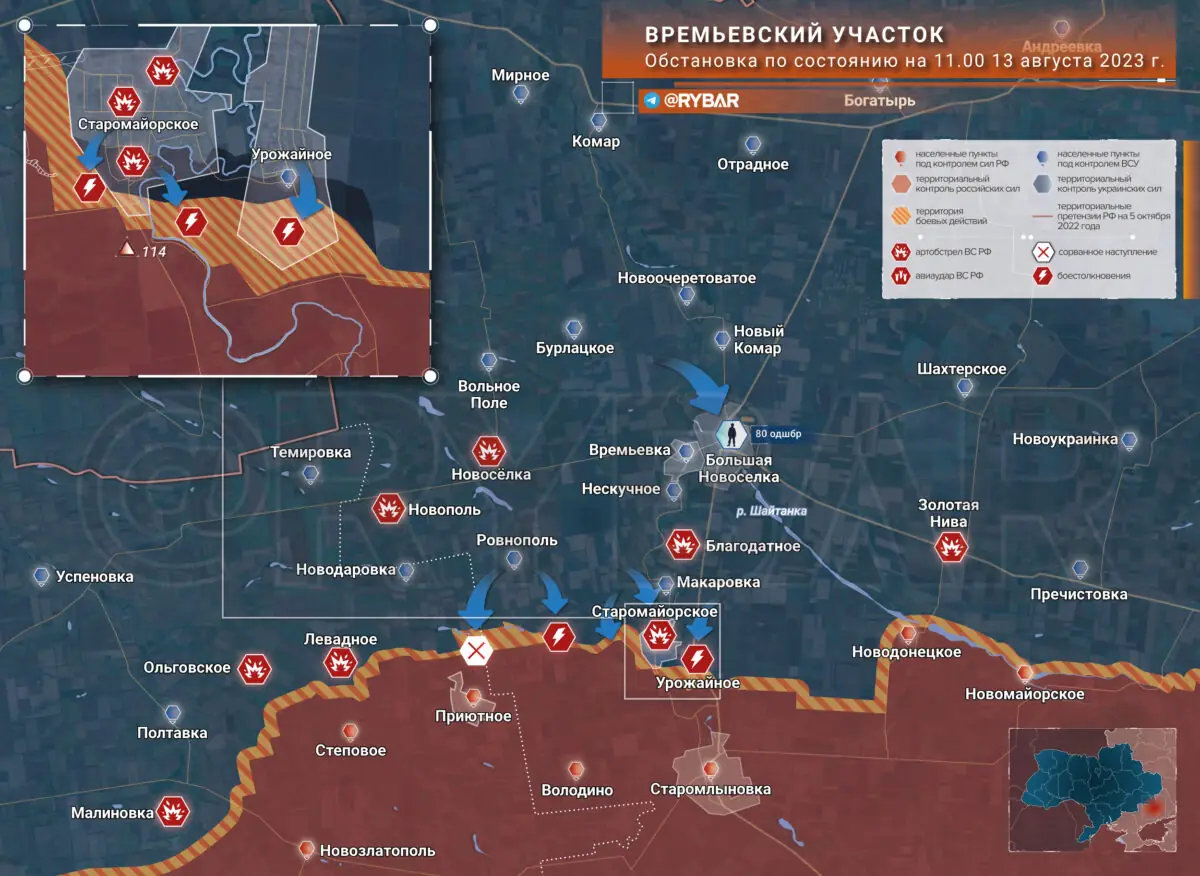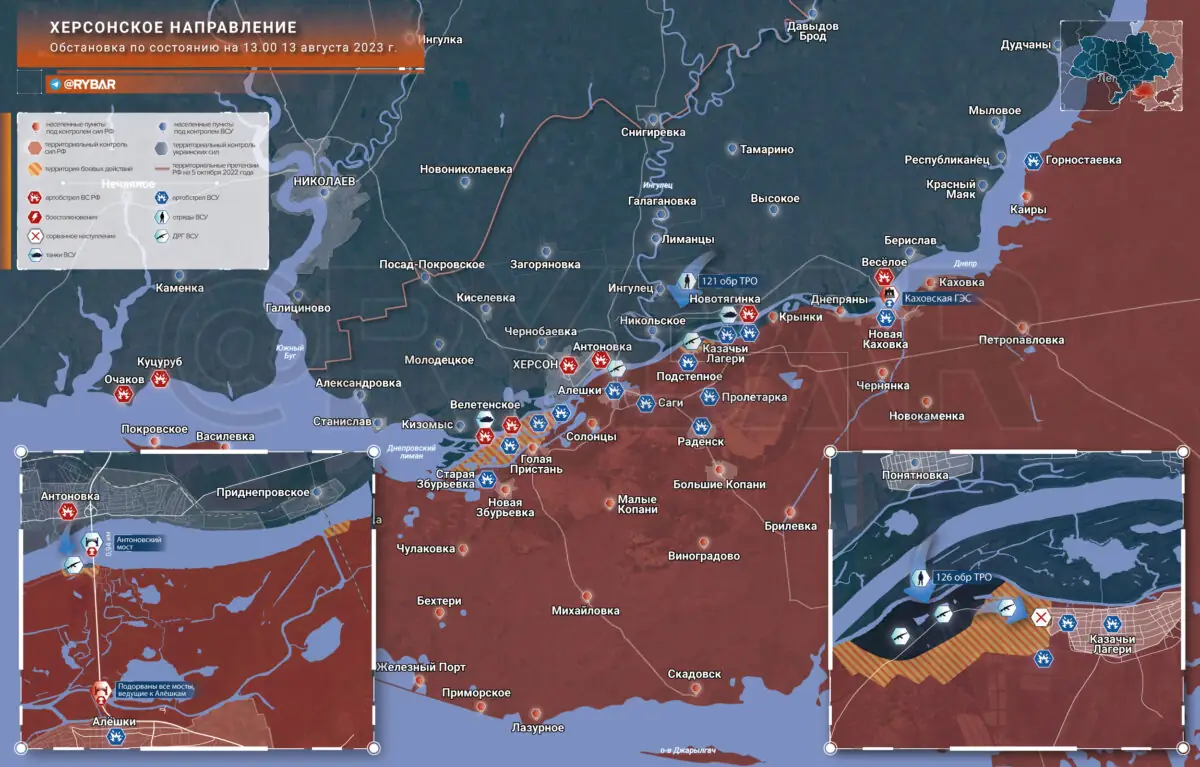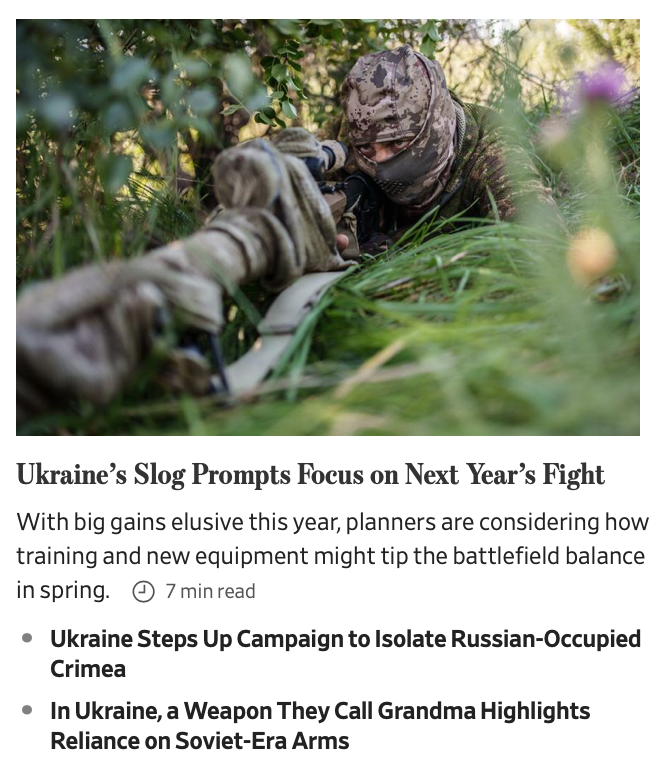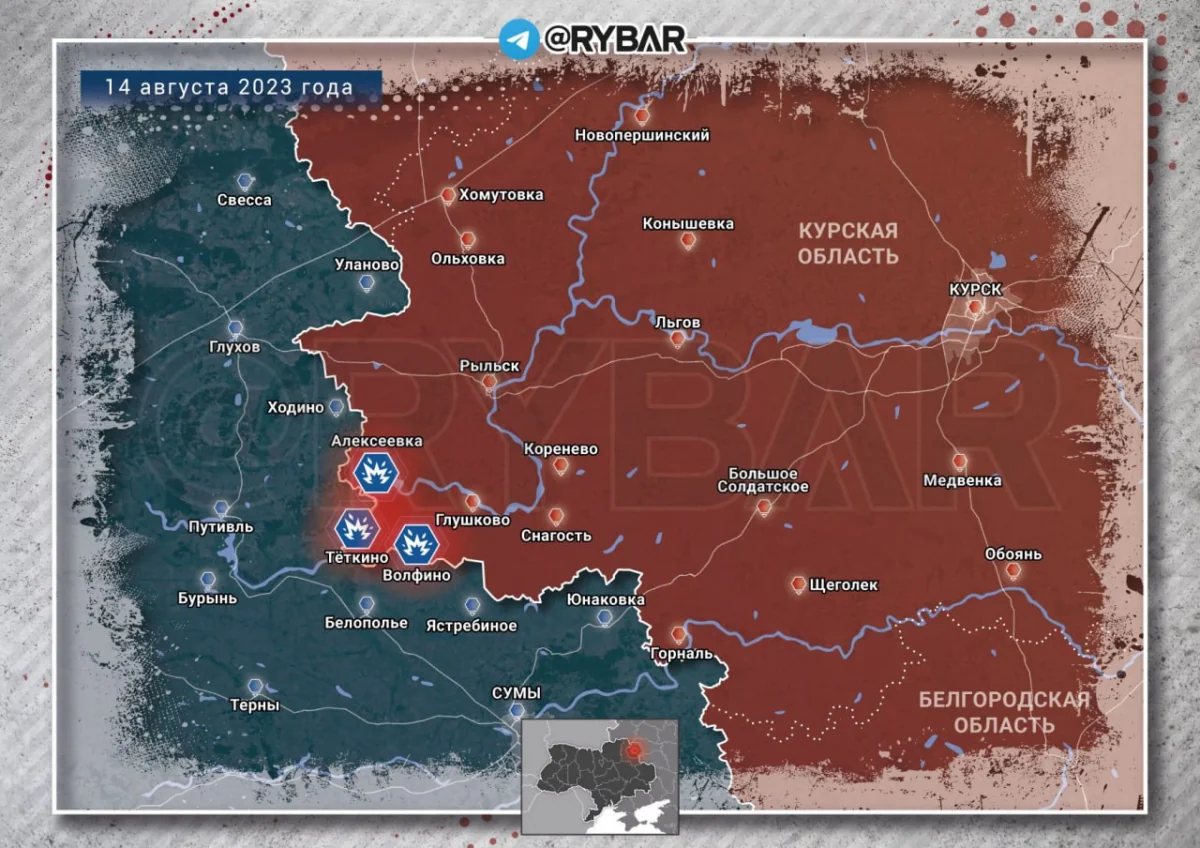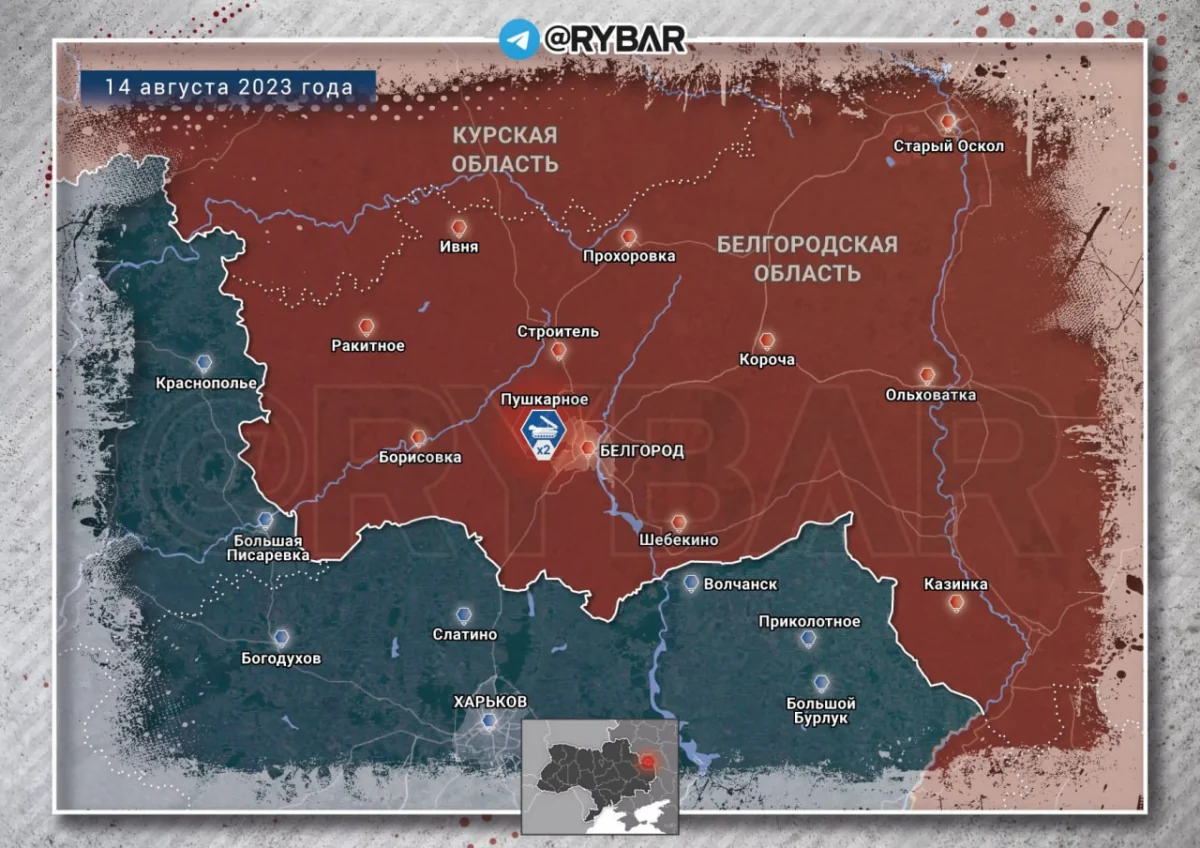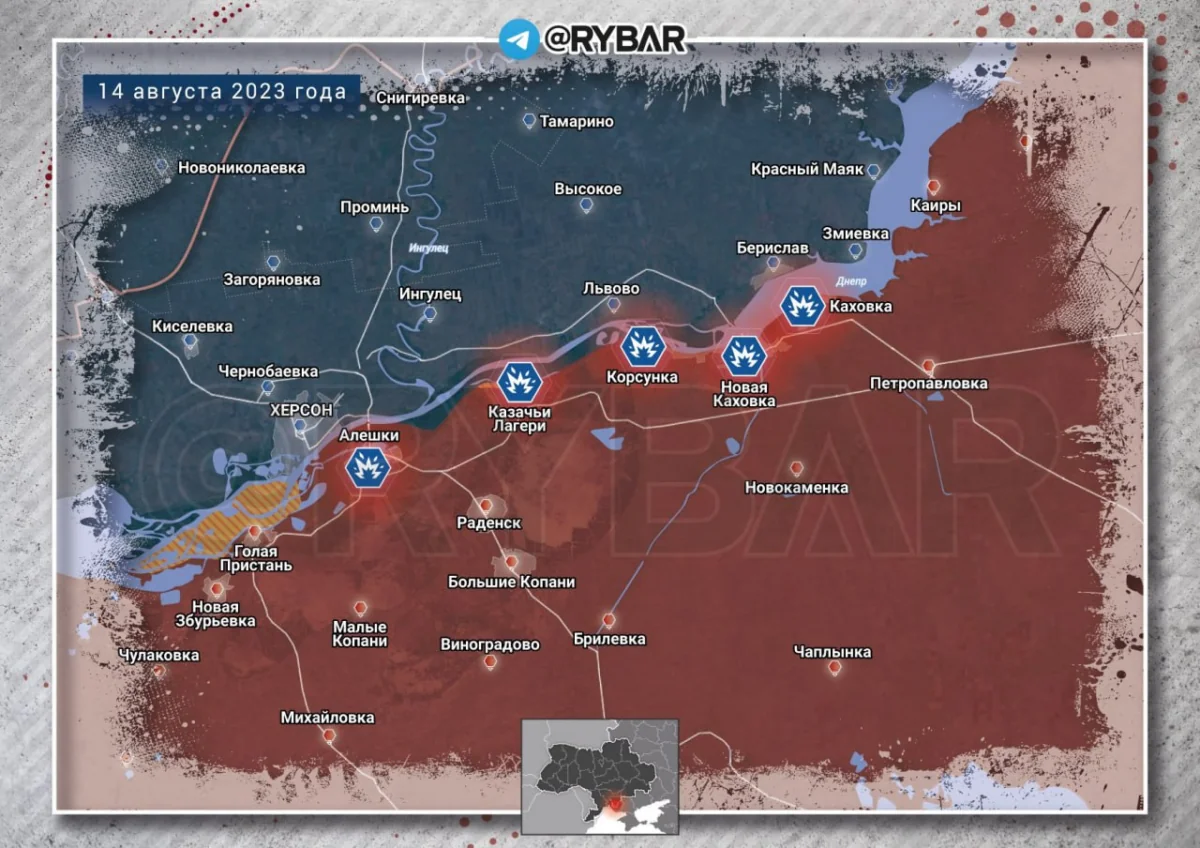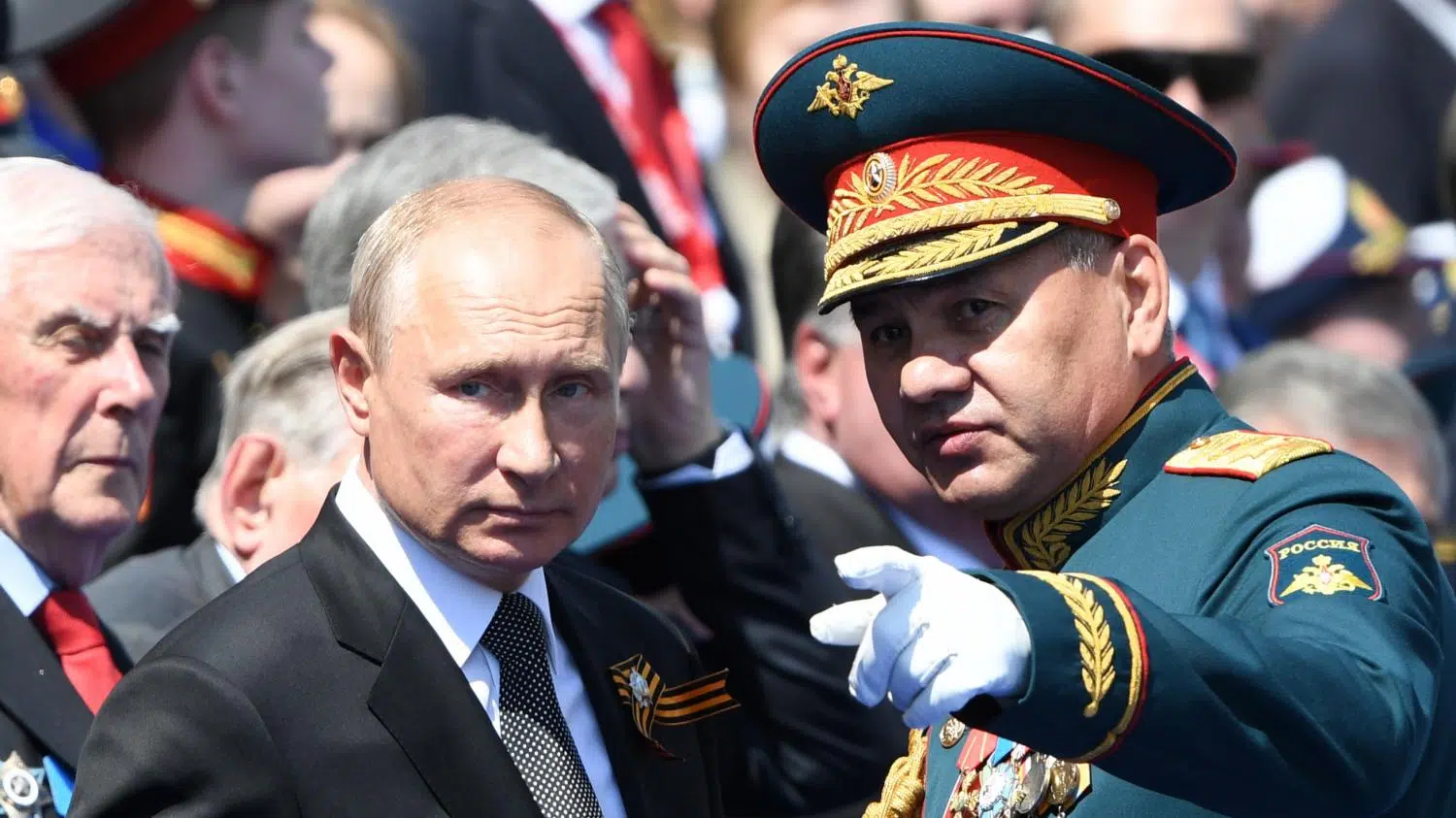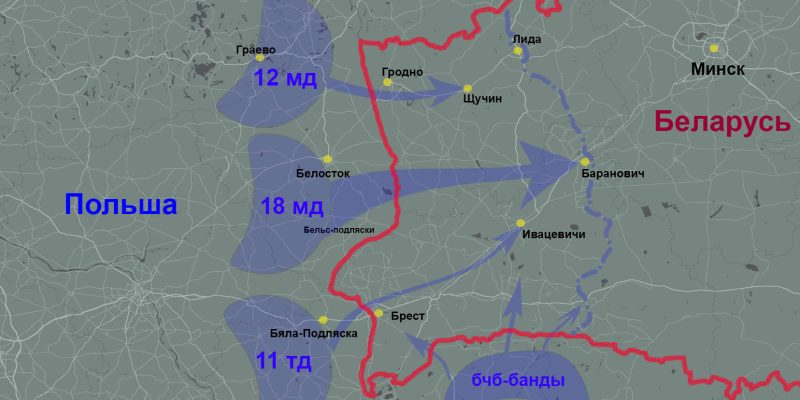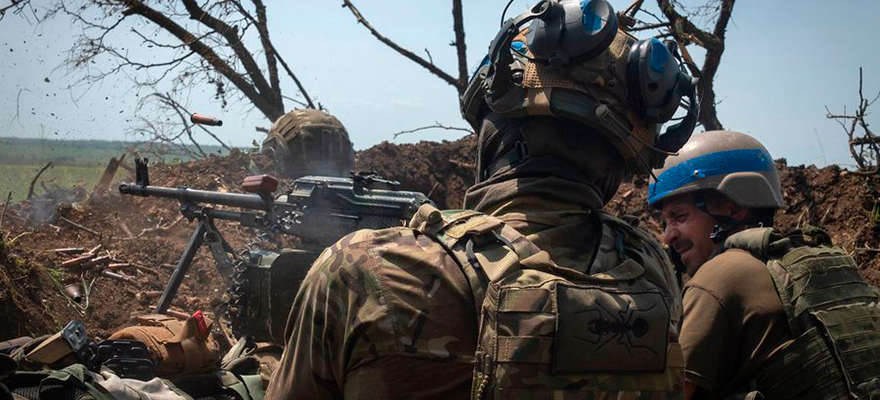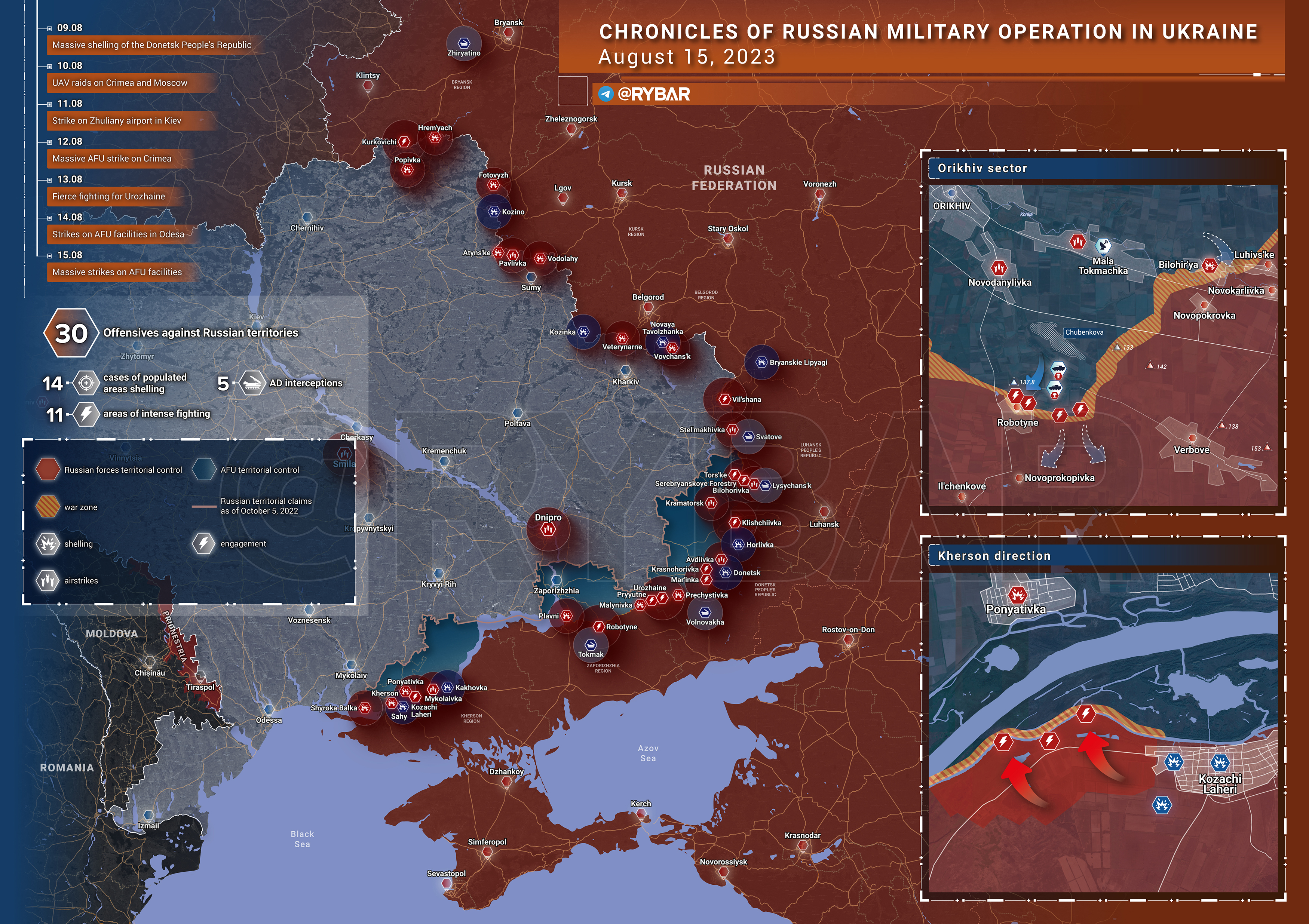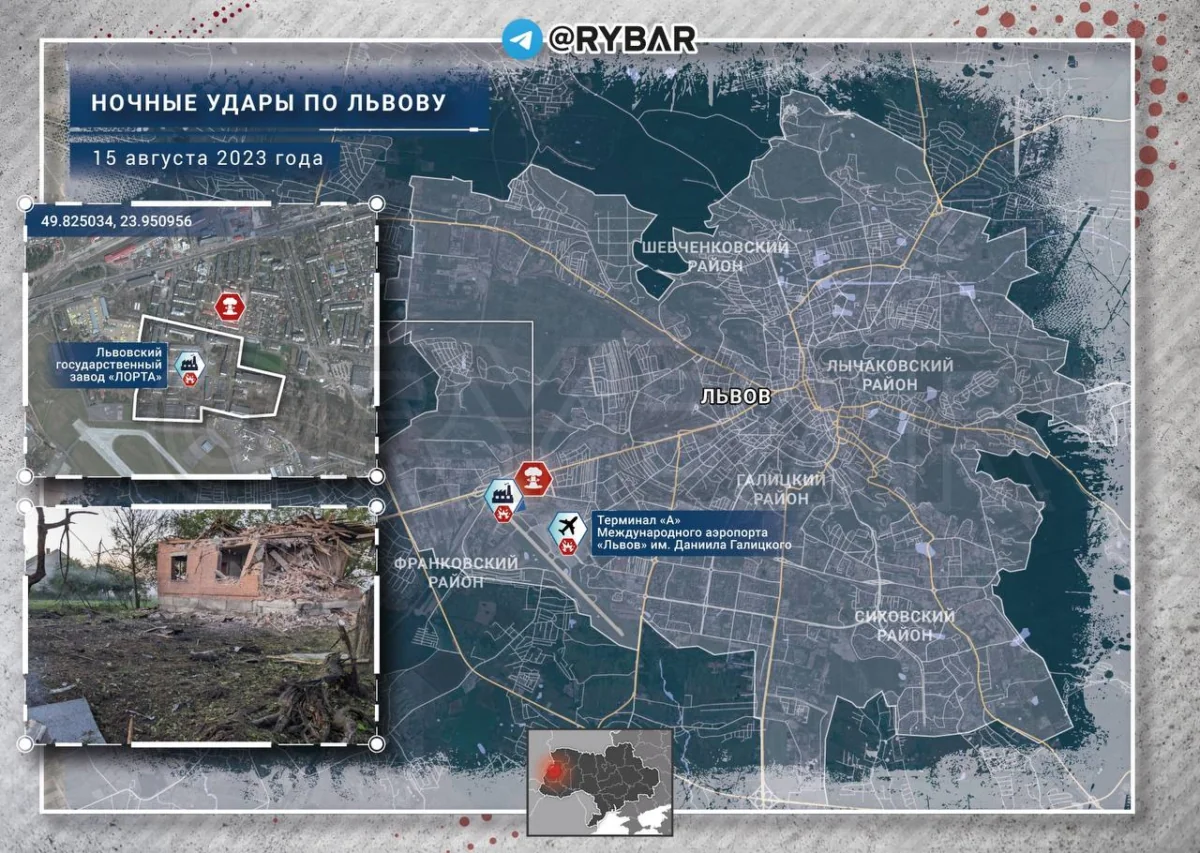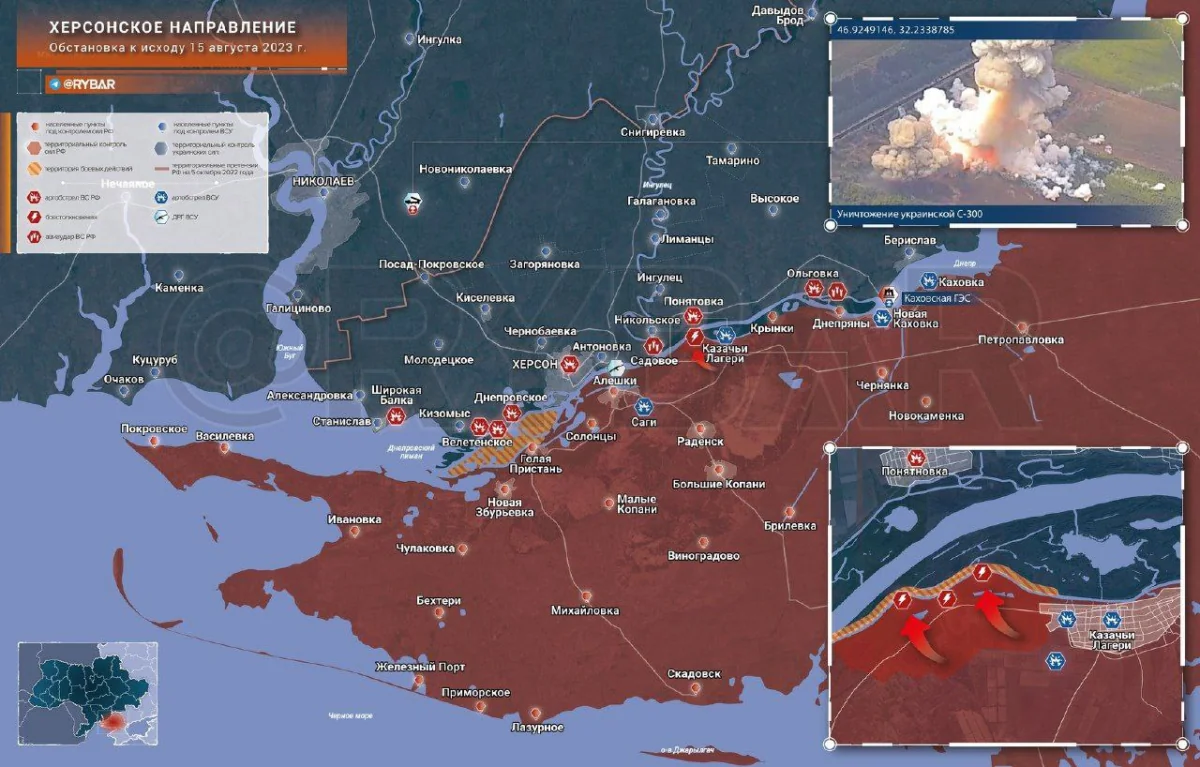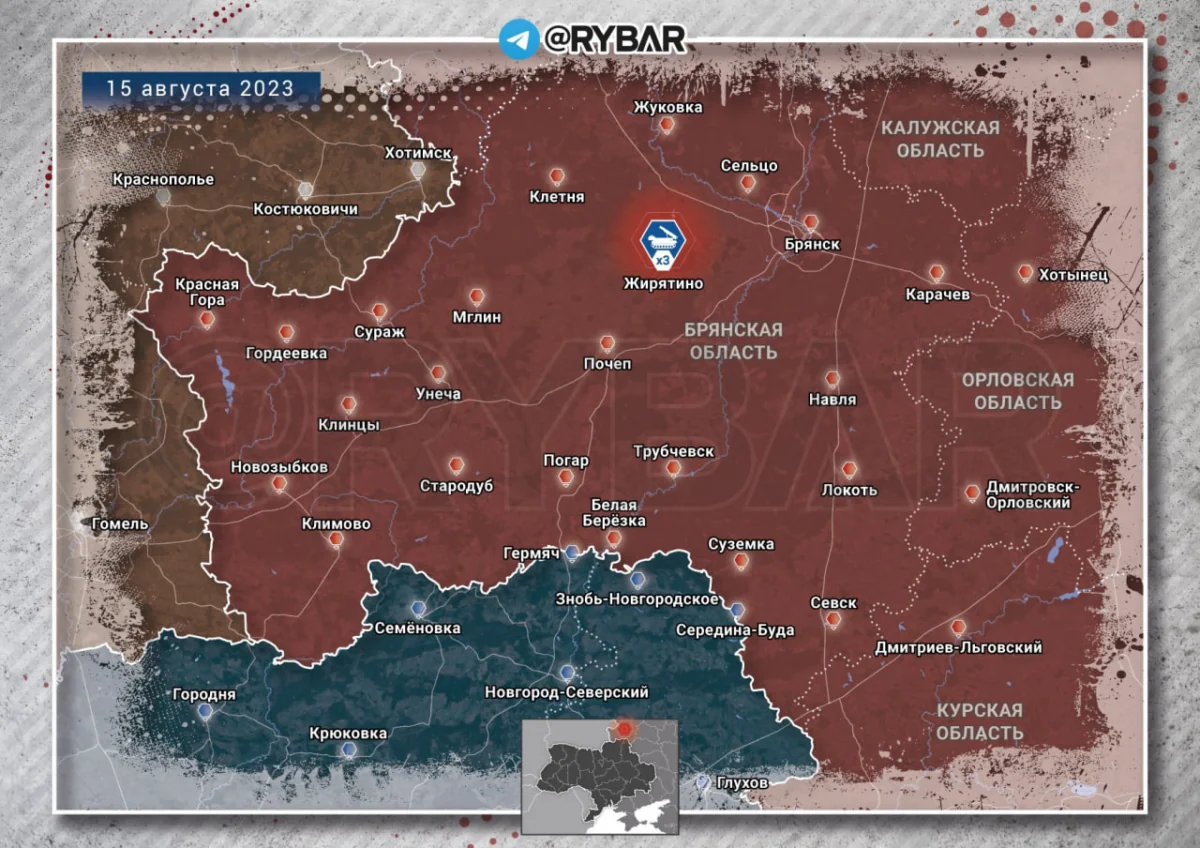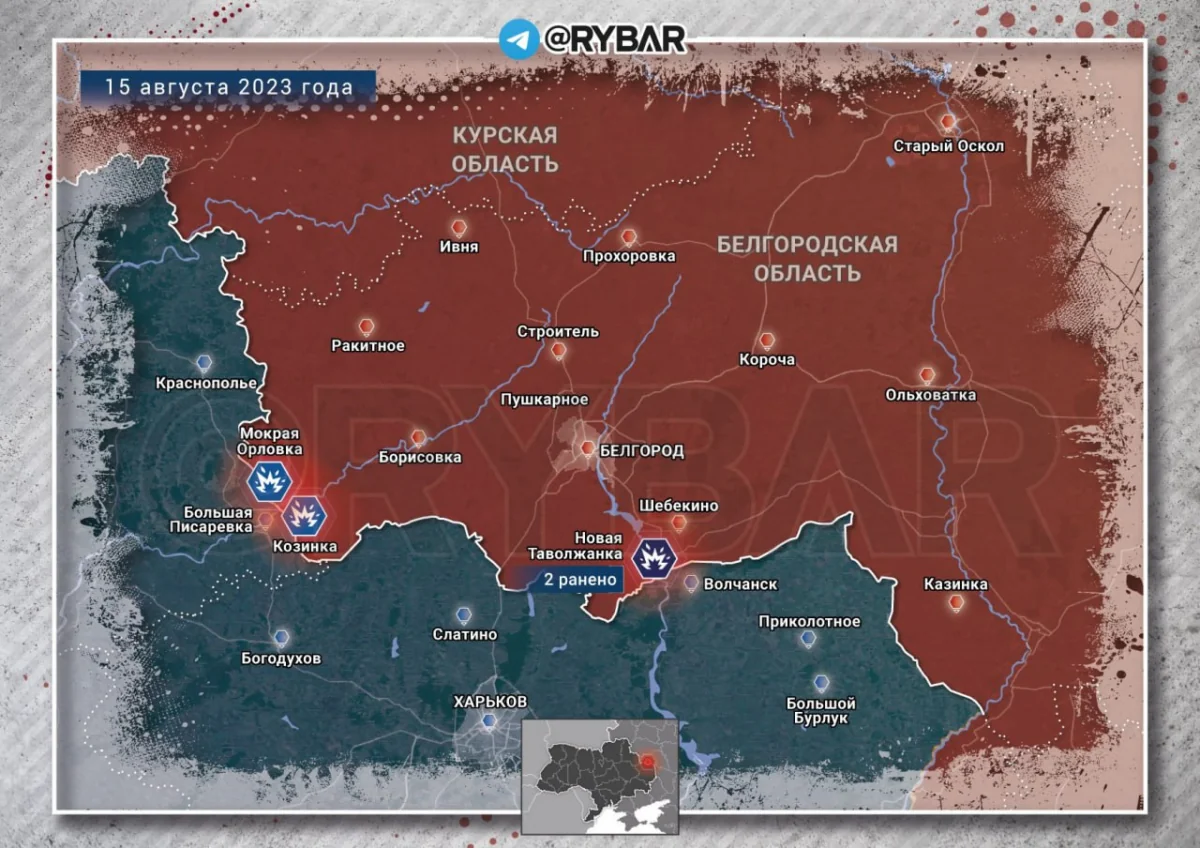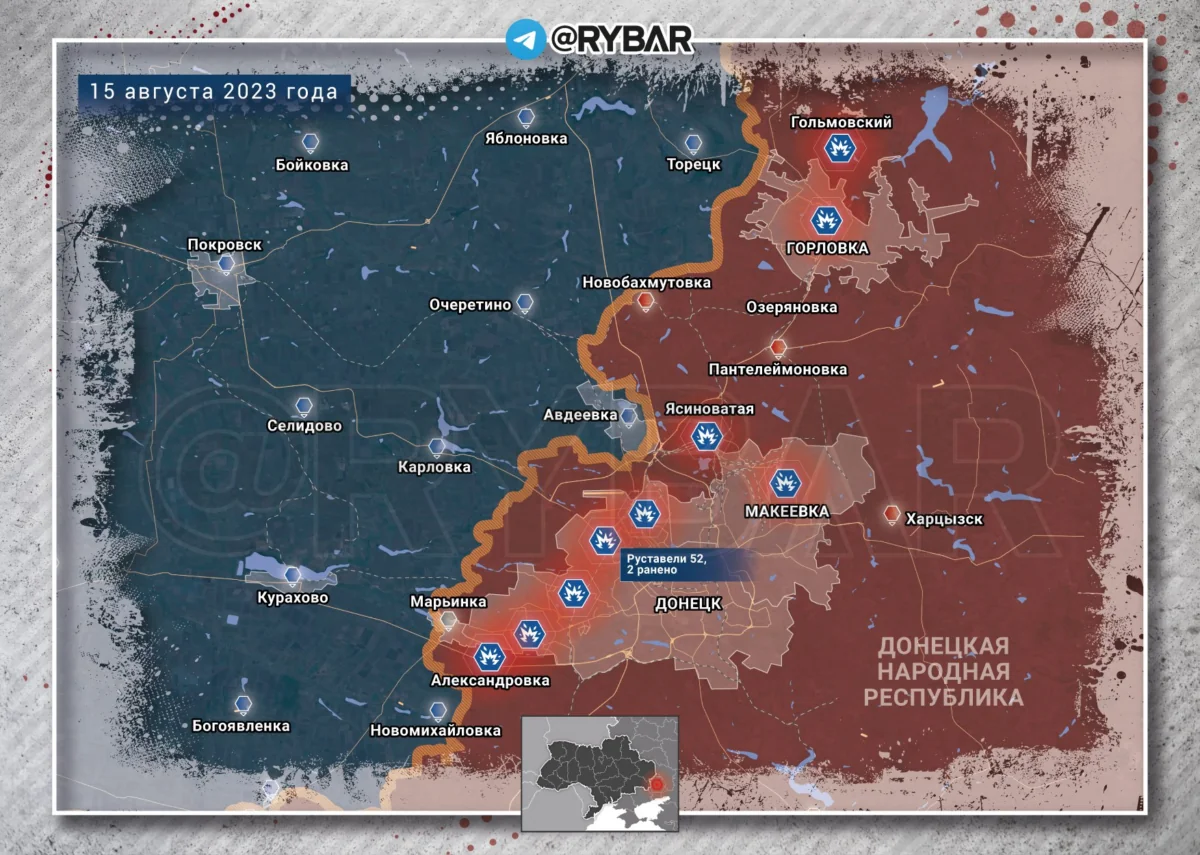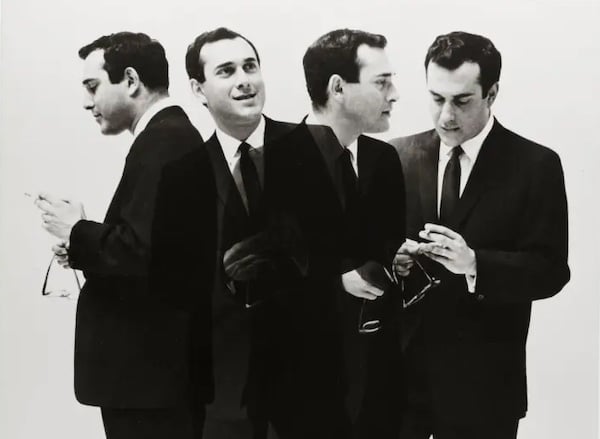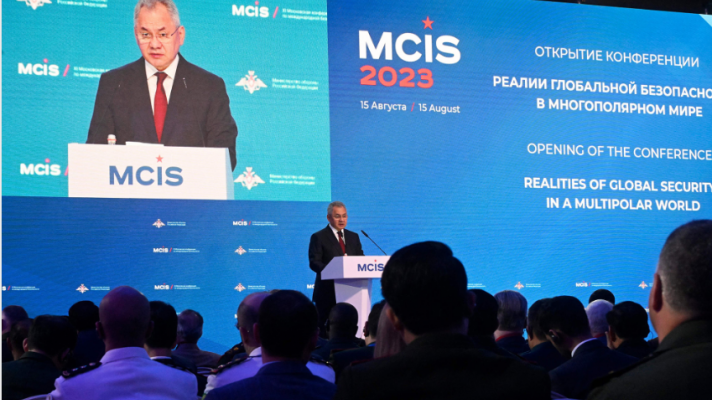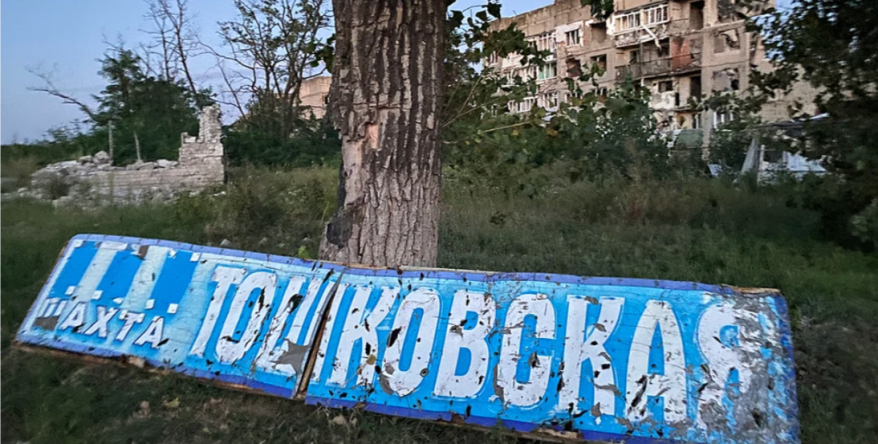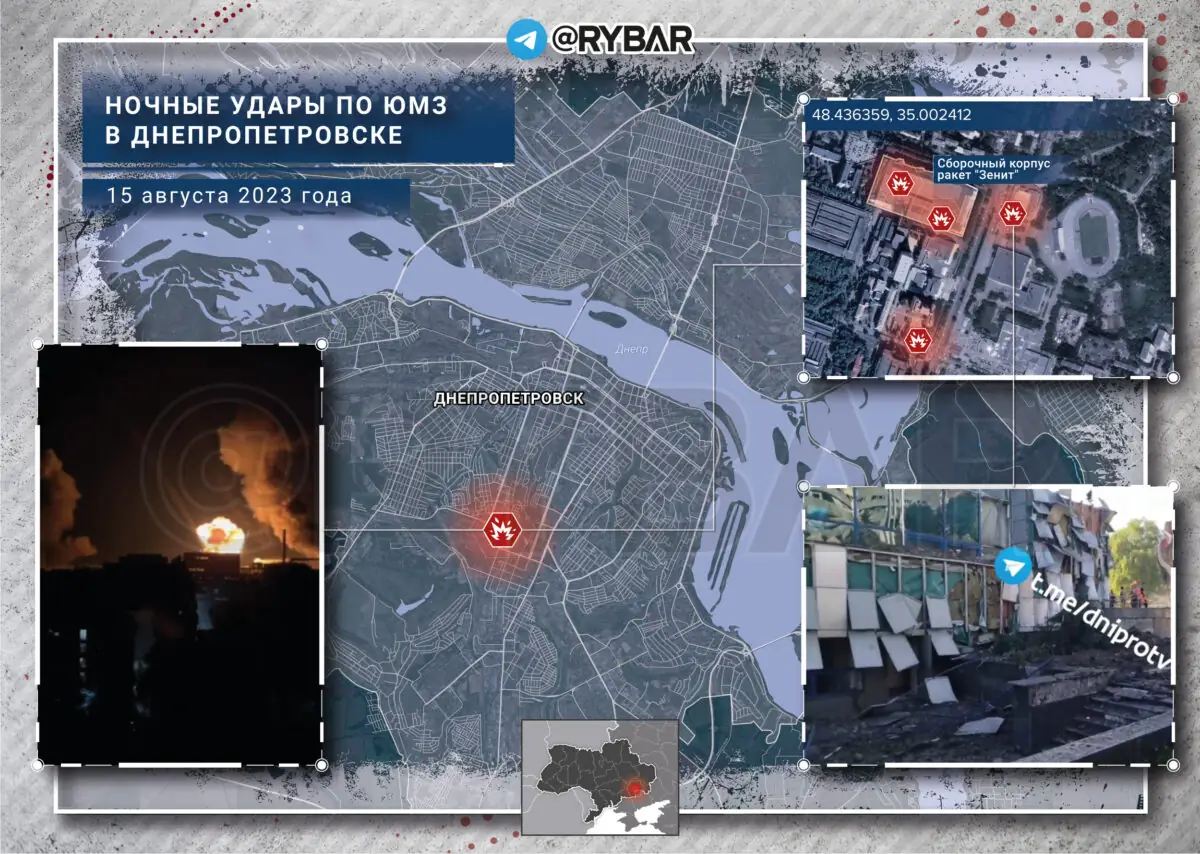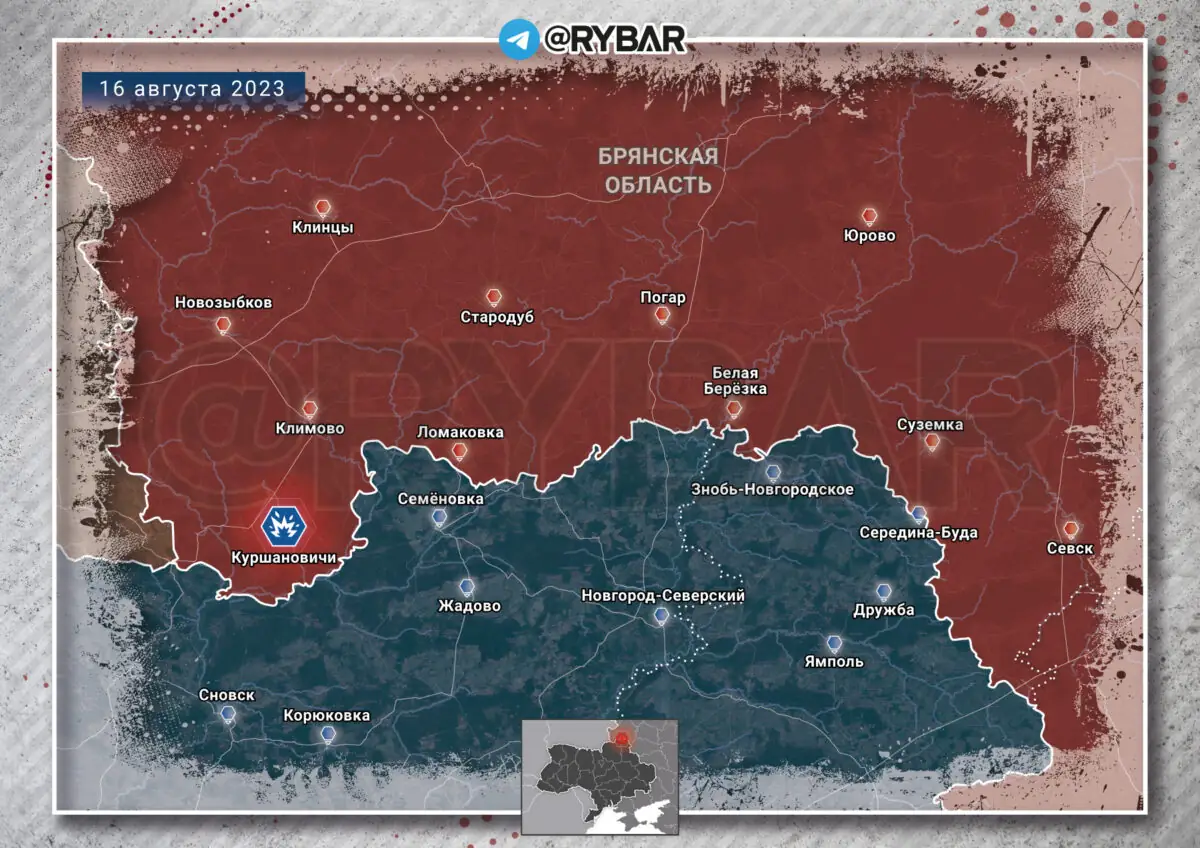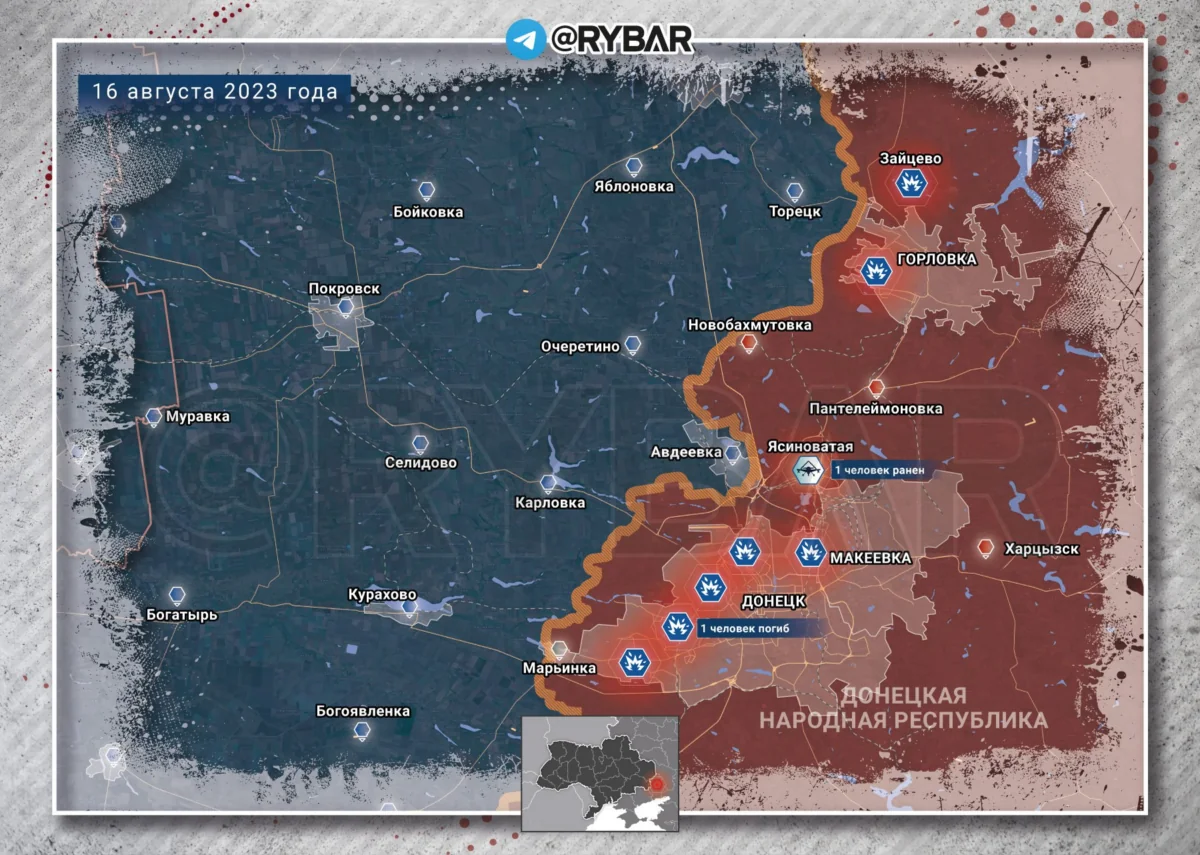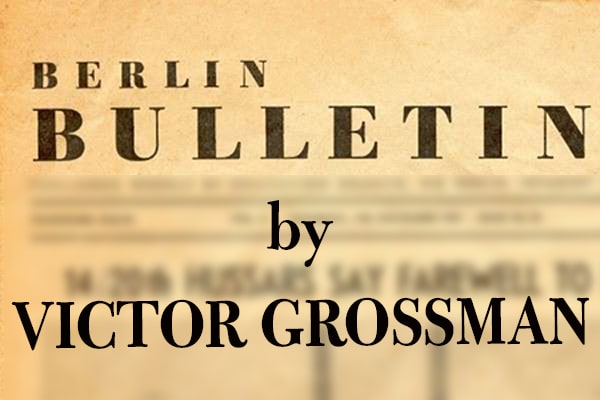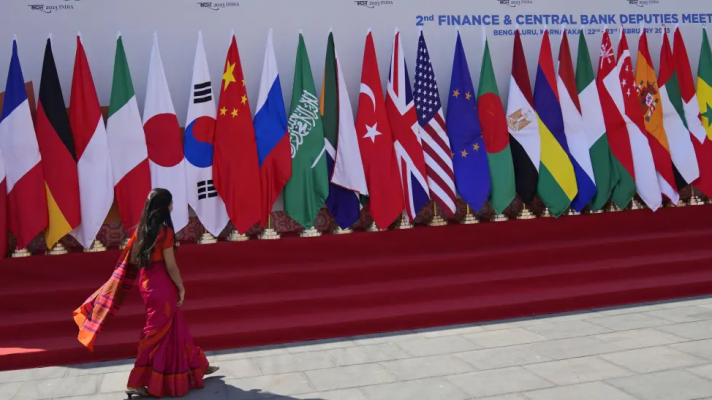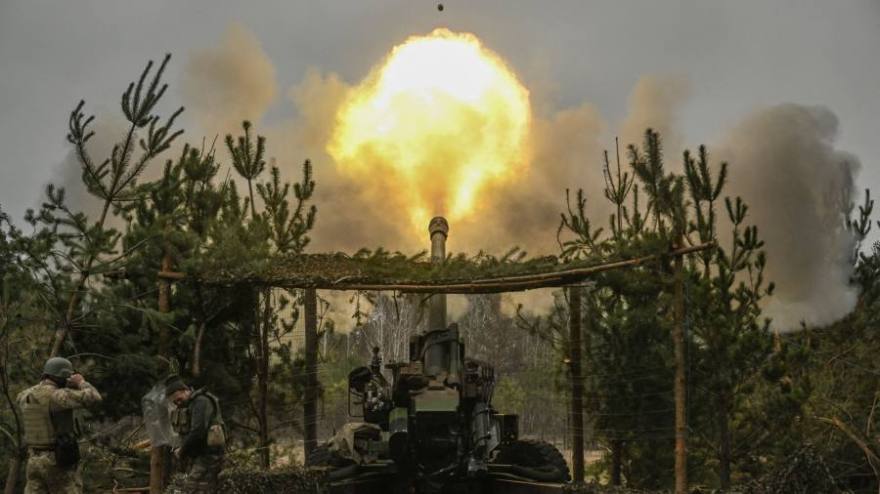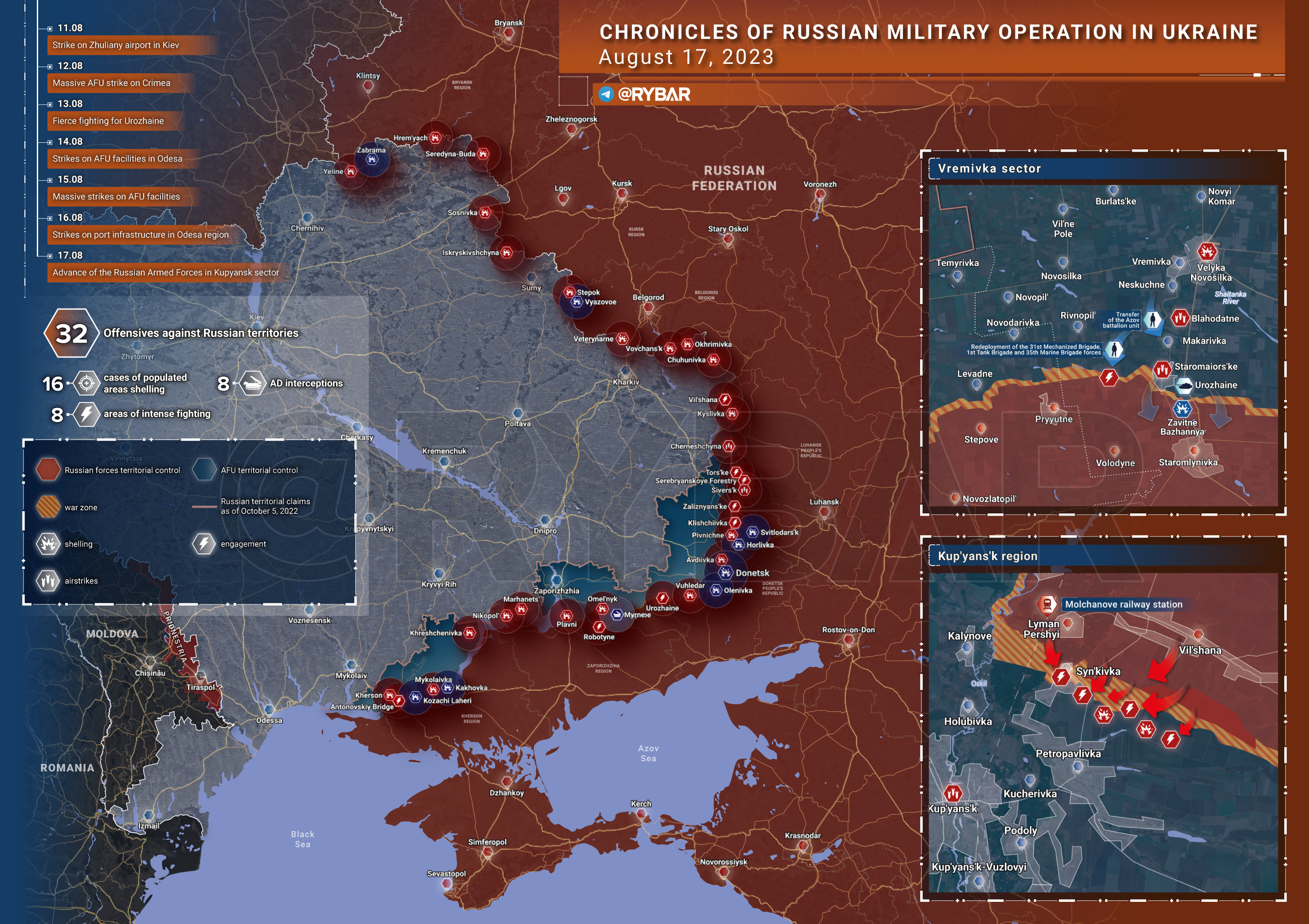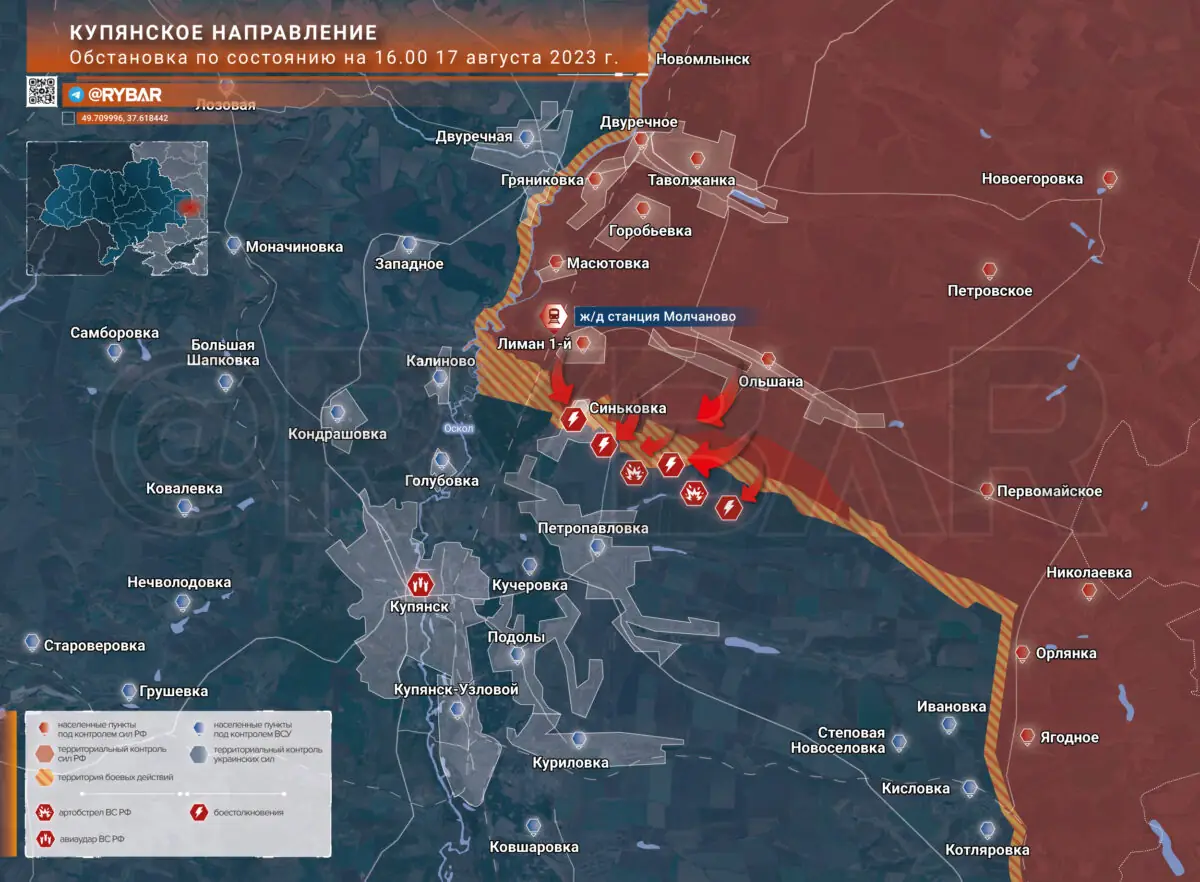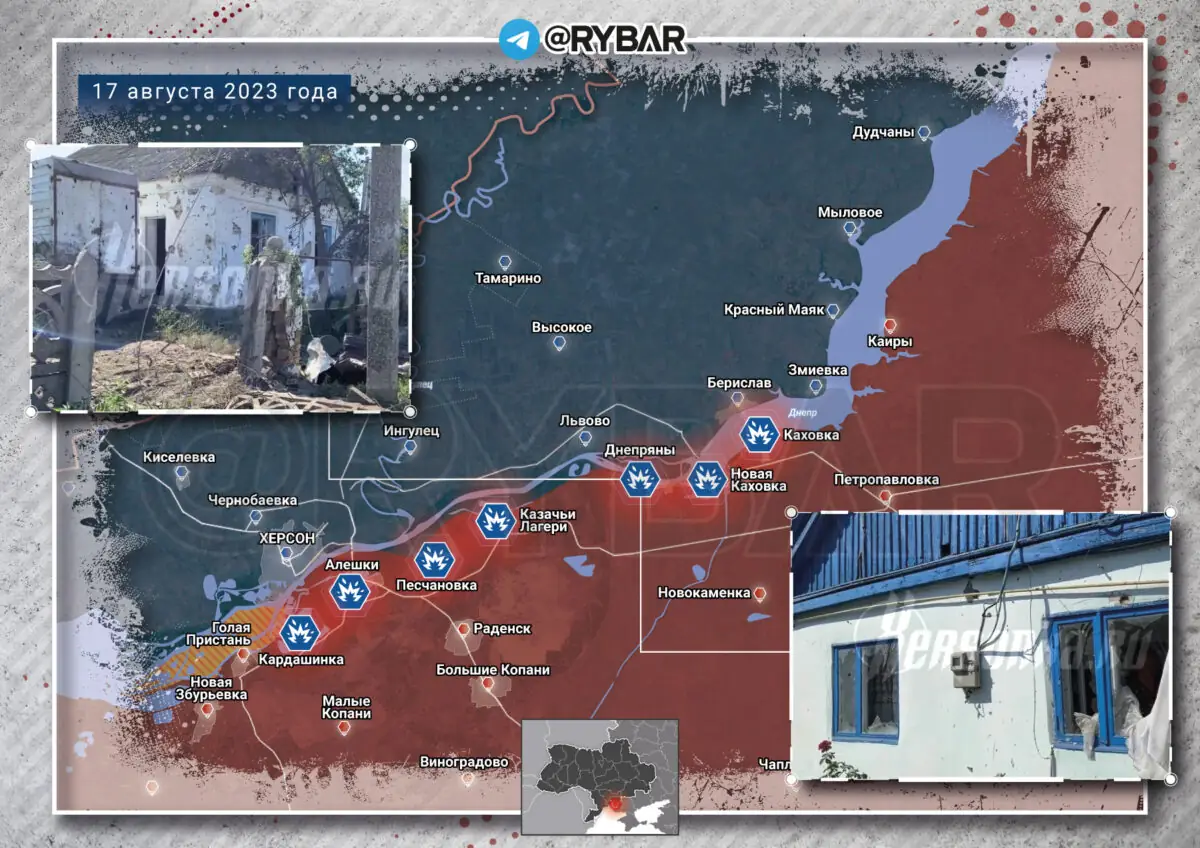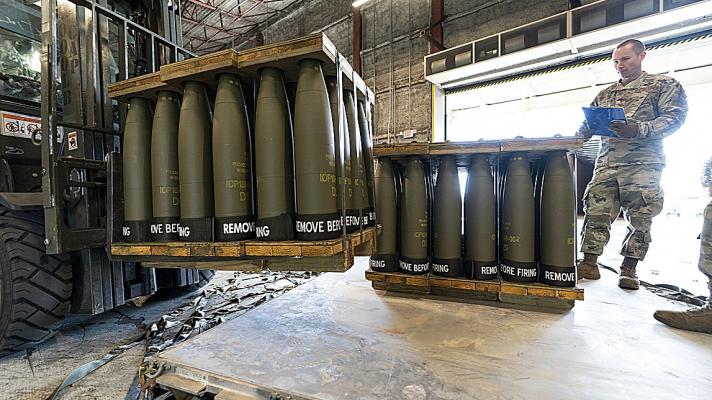August 9, 2023
Rybar
Ukrainian formations continue to look for weaknesses in the Russian defense. Today, DRGs of the Armed Forces of Ukraine landed under the cover of night in the area of the Cossack Camps on the left bank of the Dnieper in the Kherson region . On the outskirts of the settlement, the enemy was driven back and driven to the opposite side.
While the Ukrainian formations continue to roll on our defensive lines in the area of Kurdyumovka and Andreevka in the Bakhmut direction , the RF Armed Forces took control of the forest belt and strongholds south of Olshany and Pervomaisky in the Kupyansky sector.
At the Vremyevsky section , the Armed Forces of Ukraine made an attempt to enter Urozhaynoye , but were thrown back to their original positions. In the Orekhovsky sector, the enemy tried to capture strongholds of the RF Armed Forces in the Rabotino area , but was unsuccessful.
The daily shelling of Russian territories continues. Civilian infrastructure in the LPR , Bryansk , Belgorod , Kursk and Kherson regions , as well as in the Donetsk People's Republic , were hit , where three people were killed and 12 others were injured in continuous strikes.
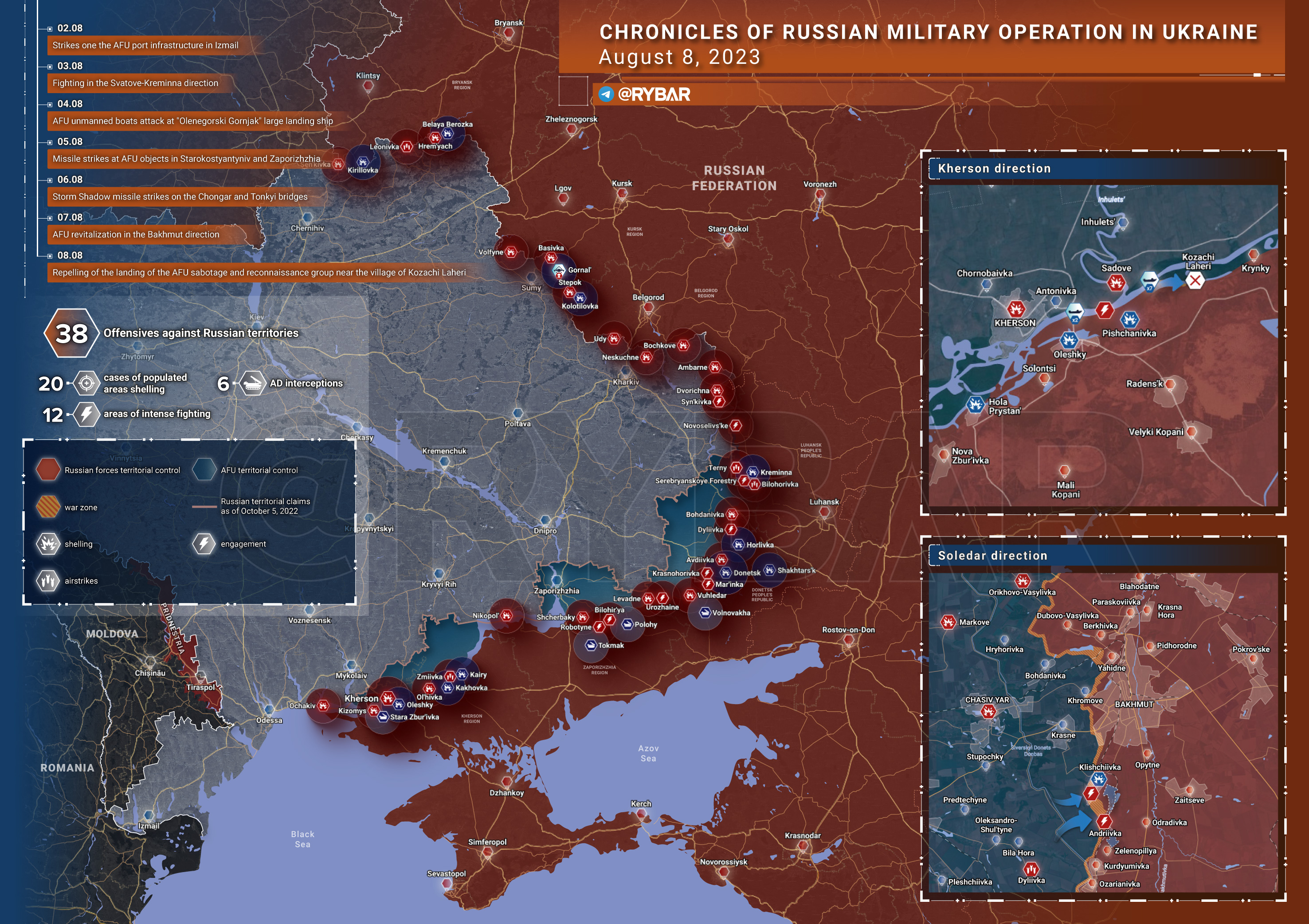
Attack on the accumulation of armored vehicles of the Armed Forces of Ukraine near Andreevka

The VerumReactor channel published footage of the destruction of a cluster of armored vehicles of the Armed Forces of Ukraine west of Andreevka in the Bakhmut direction . The calculation of the UAV of the 72nd Omsbr detected the movement of the enemy, who was probably preparing for the next assault on the positions of the Russian army near Andreevka. As a result of a concentrated strike, at least one MRAP was destroyed. In addition, an armored personnel carrier-4 can be seen in the frame, and an unidentified armored personnel carrier with a mine sweep. The attacks of Ukrainian formations on the village intensified. Due to the lack of progress in Kleshcheevka , the Armed Forces of Ukraine decided to force the Russian troops to retreat by striking from the flank. But at the moment, Russian fighters successfully repel the offensive.
The situation on the front line and the fighting

In the North Ukrainian direction in the Sumy region, a high concentration of the enemy remains, judging by the number of subscribers of satellite terminals along the Belgorod and Kursk regions . This indicates the setting of backup communication channels. Despite the lack of visible action, such activity also indicates a possible future activation of Ukrainian DRGs in Russian territories. Previously, terrorists from the so-called "Russian Volunteer Corps" have already been noted in these areas .
Also, the transfer of units of the 58th armored personnel carrier of the Armed Forces of Ukraine is expected to the Belgorod region, which is currently being re-equipped at the training ground in Goncharovsky inChernihiv region . In addition, about one and a half thousand people are concentrated at the Ugroeds - where the border crossing Kolotilovka - Pokrovka has earned . And the presence of such a contingent is directly related to the plans of the Armed Forces of Ukraine in this direction.
The Ukrainian command is considering the option of attacking the Russian regions. Moreover, the operation is led by Major General Melnik . Given the number of forces near the peaceful corridor that has been launched, provocations on the border and the subsequent transfer of DRGs to Russia are not ruled out.
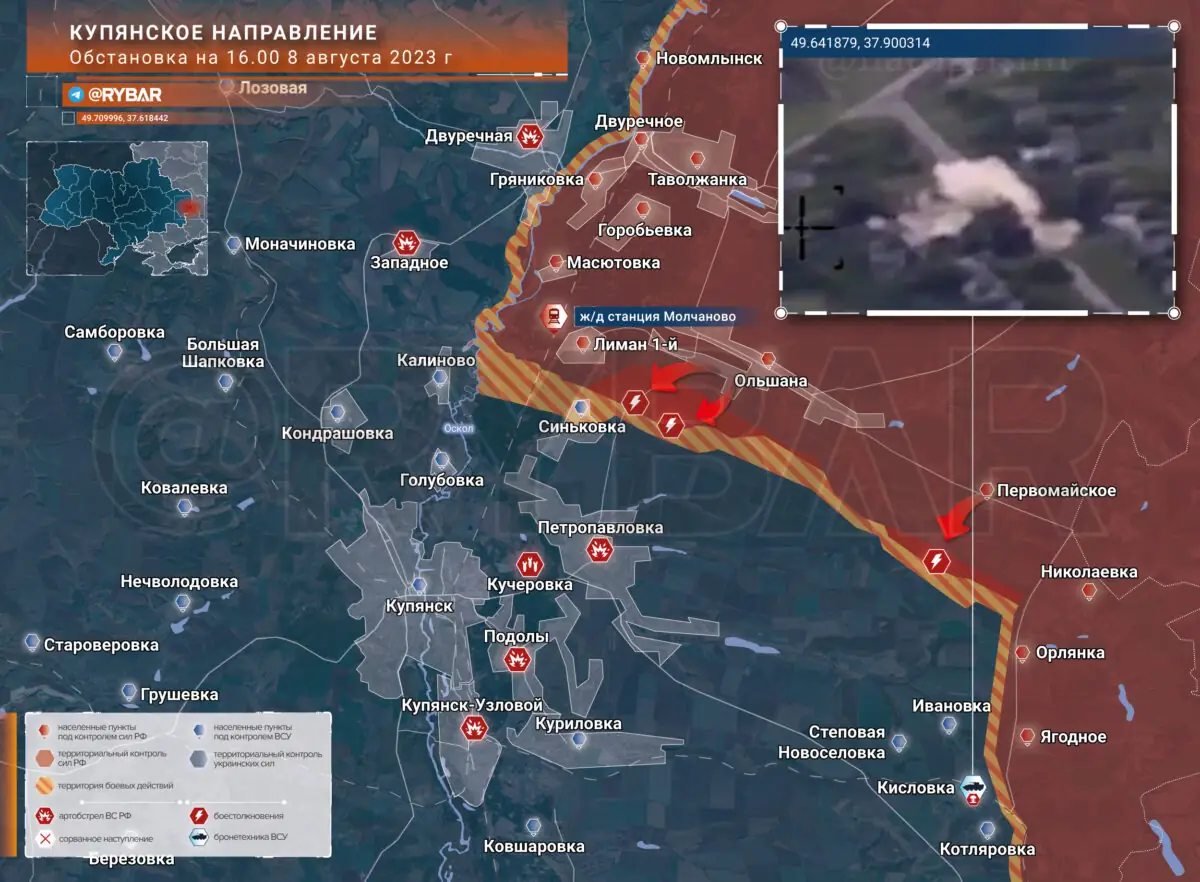
In the Starobelsk direction near Kupyansk, servicemen of the West group of the RF Armed Forces continue their positional offensive. As a result of the attack on the Liman 1st-Pervomaiskoye sector , Russian fighters knocked out formations of the 14th Ombre of the Armed Forces of Ukraine from several strongholds. At the moment, the Russian army has taken important positions at the landings south of Olshany and Pervomaisky . The line of control runs along forest belts adjacent to settlements.
At the same time, to the south, scouts from the 1st Tank Army of the RF Armed Forces discovered an armored personnel carrier of the Armed Forces of Ukraine in the village of Kislovka , southeast of Kupyansk, and hit it from an anti-tank complex. Due to a serious deterioration in the situation, the command of the Armed Forces of Ukraine transferred additional detachments of the 95th Airborne Infantry Brigade of Ukraine to Sinkovka to help the 14th brigade and consolidated rifle formations.
Also, enemy mechanized units arrived in the Dvurechnaya area. It is not entirely clear to which formation they belong - it is possible that they belonged to the 41st Ombre, which was earlier deployed near Kupyansk.
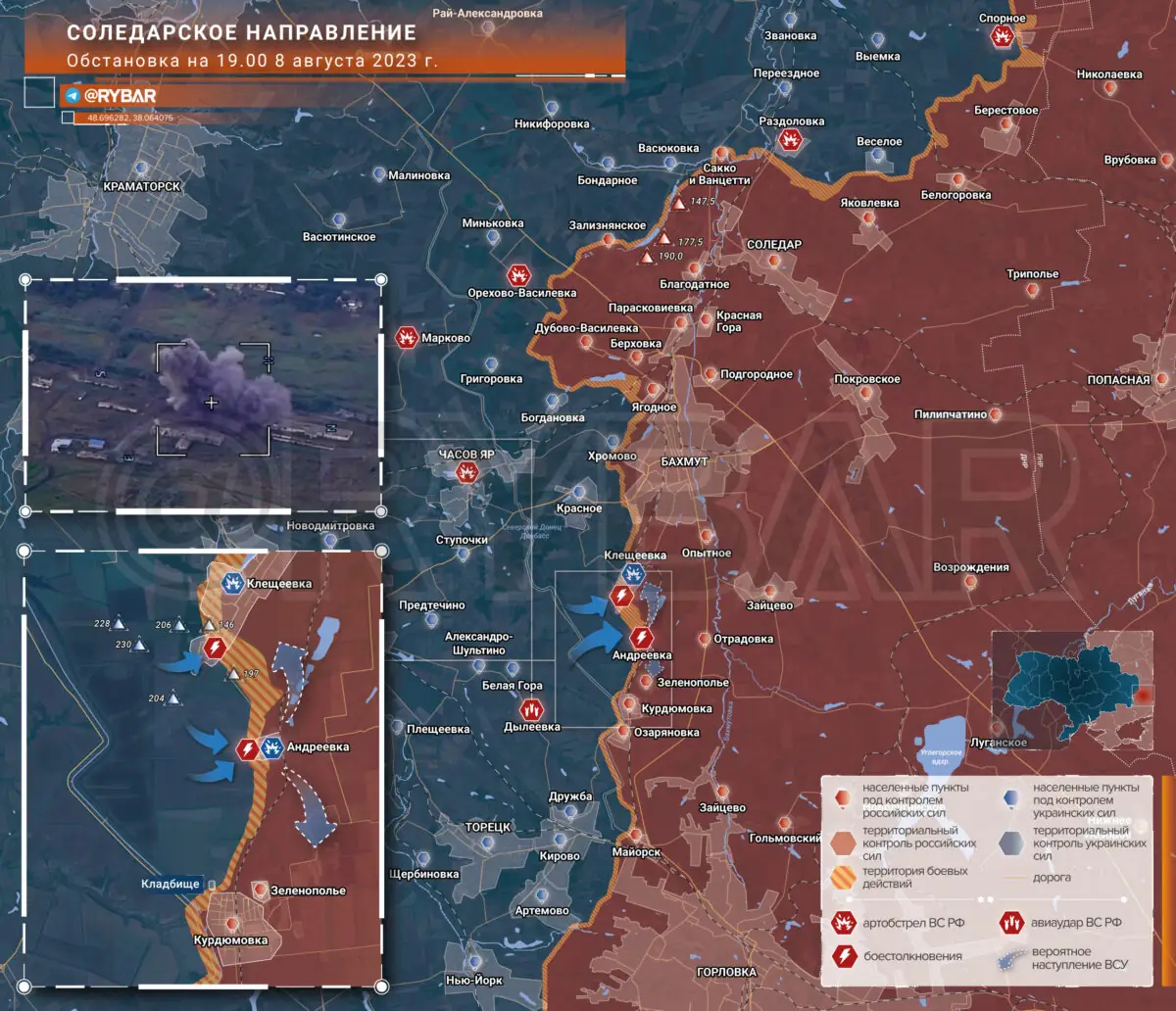
In the Soledar direction, after a few days of a relatively stable situation, the Armed Forces of Ukraine again launched an offensive at the Andreevka-Kleshcheevka line . After artillery preparation by the forces of the 22nd brigade of the Armed Forces of Ukraine, they went on the attack. As well as in other areas of the Armed Forces of Ukraine, only infantry assault groups are involved. Artillery and tanks support the advancing fire. The front line is currently in the fog of war - strongholds are changing hands.
Russian paratroopers report repulsing most of the rollovers. Colleagues from the Vystrel channel report on enemy attempts to break through Andreevka to Kleshcheevka , where battles have been going on for many weeks.
The units of the RF Armed Forces at the forefront are actively assisted by aviation and artillery. According to the interception of negotiations between members of the Armed Forces of Ukraine, an ammunition depot was destroyed in Krasnoe . A similar hit was noted in Dyleevka . The situation is difficult, but manageable. The enemy presses, trying to gain a foothold in settlements, and does not take into account losses. With success on the southern flank, it is likely that the Armed Forces of Ukraine will move towards Kleshcheevka and the Kurdyumovsky triangle .
The situation in the Donetsk direction remains the same: positional battles and artillery duels are taking place in the Maryinsky and Avdeevsky sectors , the parties are actively using drones, and also arrange attacks on enemy positions. The Armed Forces of Ukraine, having no great prospects in this sector of the front, continue to terrorize the local population.
In the Avdiivka direction, Russian troops discovered a firing point of the Armed Forces of Ukraine, after which heavy fire from our artillerymen from the 9th brigade fell upon the enemy.

In the Vremievsky sector yesterday late in the evening, the consolidated assault groups of the 35th and 36th infantry regiments, with the support of the 1st brigade and the brigade-artillery group of the 72nd Ombre of the Armed Forces of Ukraine, began the assault on Urozhaynoye from the north and northeast. By midnight, Ukrainian formations were able to gain a foothold on the northern outskirts of the village, however, as a result of a counterattack by Russian troops, the Armed Forces of Ukraine retreated to their original lines.
The evacuation groups of the 128th brigade of the territorial defense of the Armed Forces of Ukraine, under the cover of artillery and electronic warfare crews, evacuated the wounded and those killed in battle. However, the attacks will resume soon. Three assault detachments of the 88th battalion of the 35th brigade of marines were transferred to the landing area northwest of Staromayorsky .
At the moment, the efforts of the opponents are concentrated on Harvest. The village itself has actually been overtaken by the fate of the neighboring Staromayorsky - it was almost razed to the ground. Despite this, the fighters of the RF Armed Forces hold the lines, but the onslaught of the Armed Forces of Ukraine is becoming stronger.

In the Orekhovsky sector, combined assault groups 116 and 118 of the 10th AK brigade attacked the Rabotino-Verbovoye line . Only infantry detachments without armored vehicles were involved in the attack.
The attack was repulsed, but in the morning the Armed Forces of Ukraine resumed the offensive with the support of artillery and the forces of the 15th brigade of the National Guard of Ukraine. At some point, they even managed to occupy the northern outskirts of Rabotino, but in the end, the fighters pushed the APU back. The fighting continues.
Also, positional battles began in the vicinity of Belogorye , where the Ukrainian command had deployed one platoon from Gulyai-Polye the day before . Activation in this area may indicate possible strike attempts in this direction.
Along with this, in the rear in the Tavriysky region , a strike force is being formed. Formations of 65 OMB and 128 OMG Brigade of the Armed Forces of Ukraine arrived there with armored vehicles. Also, additional assault units of 10 AK were transferred to Orekhov .

In the Kherson direction , due to the distraction to other directions, the situation along the Dnieper went out of public view. For several months, the Armed Forces of Ukraine continued to fire on the left bank, covering the actions of reconnaissance groups on boats. However, after the replacement of the Airborne Forces units that had been operating there for a long time with new formations, the Armed Forces of Ukraine intensified attacks on Russian positions. The goal in this case is simple - to take advantage of the inexperience and ignorance of the situation of the arrivals to create a bridgehead on the left bank.
During the night, seven Ukrainian boats landed up to seven DRGs of 6-7 men each after placing a smoke screen west of the Cossack Camps . The enemy groups took advantage of the replacement on the front line and struck from the flank, reaching a settlement on the banks of the Dnieper. The effect of surprise and belated reaction allowed the Armed Forces of Ukraine to land and advance unhindered towards the Camps, after which the Russian troops had already driven them back. According to colleagues from this direction, the Armed Forces of Ukraine went to the right bank.
And in recent days this is not the only area where the enemy is trying to gain a foothold. According to Dva Mayorov , gunfights were also noted near the railway bridge near Peschanovka , where the RF Armed Forces achieved little tactical success. Also, the activity of the Armed Forces of Ukraine remains near the Antonovsky bridge . The day before, the Ukrainian command sent two boats to replace units in this area. One of the boats was hit and went back, and the other was landed by the DRG, but was destroyed by fire.
In the Golopristan sector, three boats of the Armed Forces of Ukraine with 15 people on board planned to establish an observation post on Domakhsky Island . Under artillery attacks, the boats turned around. One was able to get out from under the fire, and two were damaged and blown up by mines.
Shelling of rear territories and residential areas

In the Bryansk region, the Armed Forces of Ukraine fired at the village of Kirillovka, Klimovsky district . As a result of the attack, one house was damaged, but no one was injured. In the village of Belaya Berezka, Trubchevsky District, several houses and an office building were damaged by the blow. The enemy fired at least six shells at a local plywood factory, no casualties were reported.

Ukrainian formations made another attempt to attack the UAV. This time, the Kursk region came under attack . A Ukrainian drone is reported to have crashed on the territory of the Nikolsky Belogorsky Monastery in the village of Gornal : the buildings of the monastery were not affected, one boy received shrapnel wounds, he was provided with the necessary assistance.
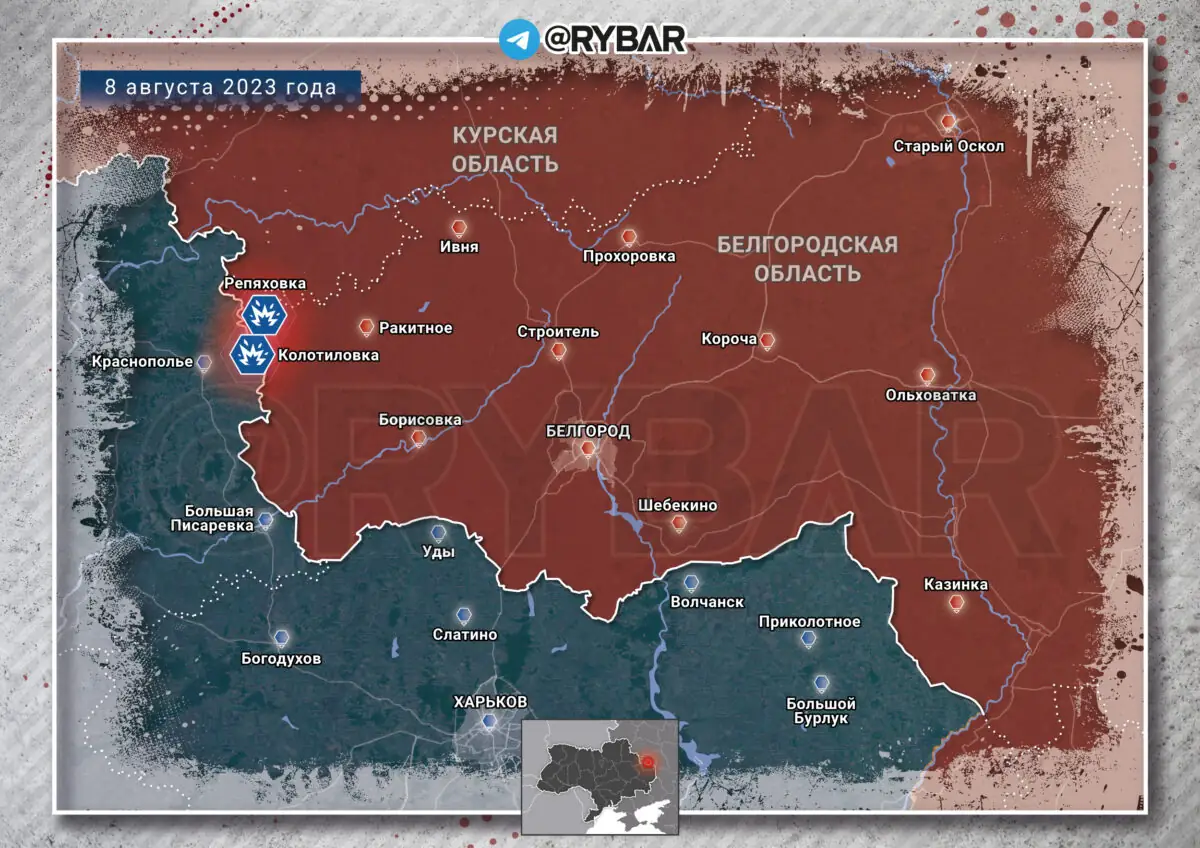
The Armed Forces of Ukraine continued to shell the border area of the Belgorod region . The village of Kolotilovka in the Krasnoyarzhsky district was hit : there are reports of at least seven arrivals. Later, the village of Repyahovka came under attack , information about the destruction and victims in all settlements was not received.

Ukrainian formations have been shelling Kremennaya almost daily for a week . As a result of the second strike on the stadium in a week, a multi-storey building and outbuildings near it were damaged. This is at least the fifth confirmed case of shelling of the city in a week, as a result of which two people were killed and four others were injured.
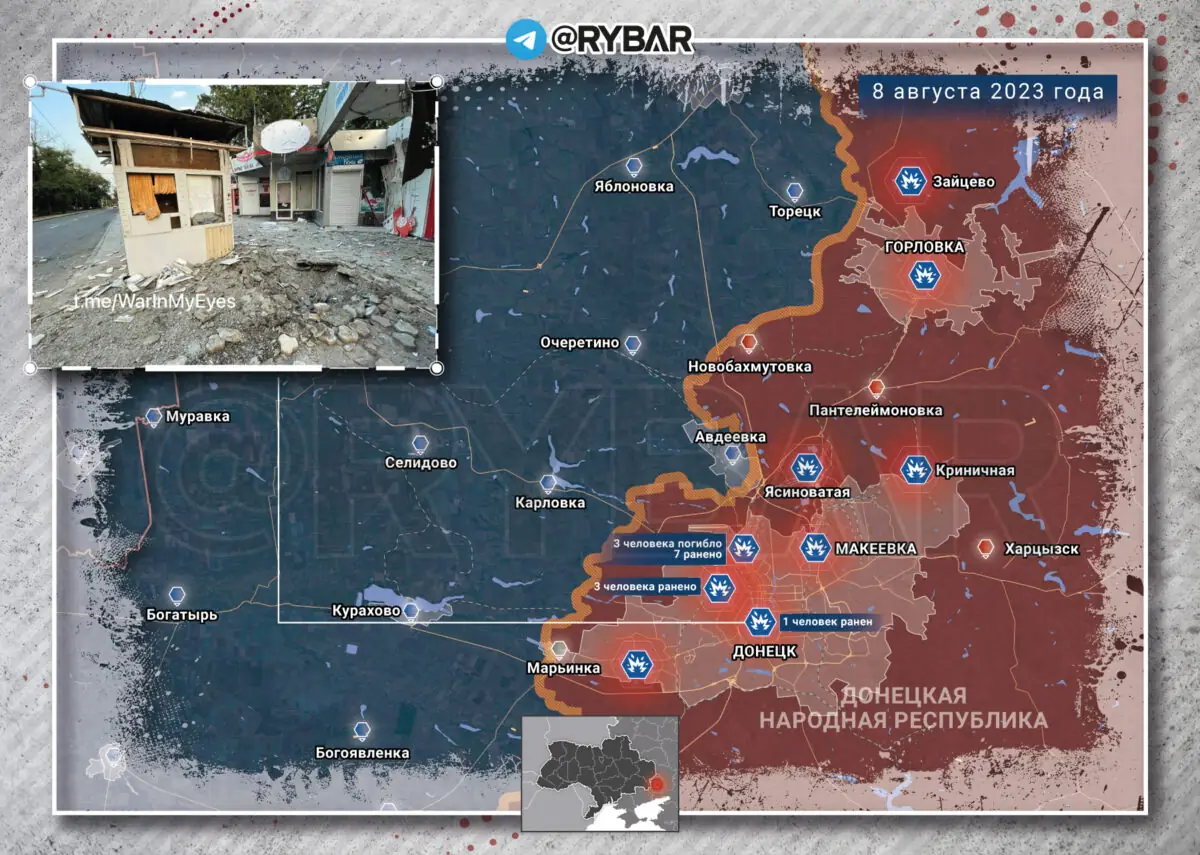
The Armed Forces of Ukraine continue daily shelling of the Donetsk agglomeration and the DPR , terrorizing the local population and destroying residential buildings and infrastructure: 95 attacks were recorded, the enemy used rocket and cannon artillery, firing over 300 ammunition, including cluster-type ammunition.
At the moment, it is known about three dead and seven wounded in the Kievsky district of Donetsk . Among the latter there is a child born in 2012. It is also reported about three victims in Kuibyshevsky and one wounded in Voroshilovsky districts . The Petrovsky district of the city also came under fire .
In addition, arrivals were recorded in the settlements of Gorlovka , Makeevka , Yasinovataya , Zaitsevo , Krinichnaya . As a result of the strike of the Ukrainian MLRS on Shakhtyorsk, one person was injured. As in the case of Donetsk, the targets of the UAF attacks were civilian infrastructure, residential buildings and crowded places.

Against the backdrop of activation on the Dnieper Islands, Ukrainian formations continue the artillery terror of the local population of the Kherson region . As a result of the shelling of Novaya Kakhovka, a fire broke out in the residential sector, which was soon extinguished. Last night, Peschanovka , Kakhovka , Cairo , Kardashinka , Aleshki and Naked Pristan were also shelled , residential infrastructure was damaged.
Political events
On Security Guarantees for Ukraine
EU Foreign Service Representative in Brussels Peter Sano said that the European Union cannot give Ukraine security guarantees. According to the official, the EU, in principle, cannot act as a guarantor of security, since it is not a defense organization, unlike NATO. “We are not a security organization. This is a discussion for NATO and individual countries, but not for the EU as an organization,” Sano said.
On the new draft law on mobilization in Ukraine
In Ukraine, they reacted in a curious way to numerous high-profile scandals with a general conscription of unfit for service: a draft law on “improving the mobilization process” was registered in the Verkhovna Rada. According to the text of the document, its authors propose sending people who are not ready to fight not to the front line, but to the construction of defensive structures and other work to ensure the functioning of the economy in wartime conditions.
If this act is adopted, the Kyiv authorities will kill two birds with one stone - they will partially reduce public discontent and at the same time create a new vein of corruption on a semi-legal payoff from mobilization. After all, as local users reasonably noted, the level of a citizen's unpreparedness for war will be clearly proportional to the amount of his contribution to the military commissar.
On the visit of the Head of the GUR of Ukraine Kirill Budanov to Bulgaria
The head of Ukrainian intelligence paid a working visit to Bulgaria and met with Defense Minister Todor Tagarev . According to Ukrainian media reports with reference to the press service of the Bulgarian Ministry of Defense, issues of regional and international security, prospects for the development of the situation in Ukraine and other mutually interesting topics were discussed.
https://rybar.ru/hronika-speczialnoj-vo ... 2023-goda/
Google Translator
(Other images at link.)
******
U.S. GOVERNMENT ON WRONG SIDE OF UKRAINE’S WAR
SouthFront
Written by Eric Zuesse
Ukraine’s war started in February 2014, not in 2022. As NATO’s Secretary General Jens Stoltenberg said on 9 May 2023, “The war started in 2014.” He even was explicit that “You have to remember that the war didn’t start in 2022” (which was when Russia responded on 24 February 2022 by invading Ukraine).
Here is the best short video (only ten minutes long) accurately showing in the original historic video clips how it started, and it is very clear there that the U.S. Government, U.S. President Obama, started it in February 2014, by means of a coup, which the Obama Administration had had in the planning stages for quite some time. The founder and head of the ‘private CIA’ firm Stratfor even called it “the most blatant coup in history”. The smoking-gun piece of evidence proving that it had been a coup by the U.S. Government is this recording of Obama’s mastermind of the coup, Victoria Nuland, telling Obama’s Ambassador in Ukraine Geoffrey Pyatt, a month before the coup became climaxed, whom to get appointed to lead the post-coup Ukraine. And, then, the smoking-gun piece of evidence proving that even the top officials of the EU didn’t know that it had been a coup instead of the ‘democratic revolution’ that the U.S. regime claimed, is this recording of the EU’s minister of foreign affairs being told in a phone call from Kiev, by her investigator there, immediately after the coup was over, that it had been a coup. On 4 November 2019, after enough verified evidence had become known about it and about how the war in Ukraine had actually been started by the U.S. Government, I headlined “The Obama Regime’s Plan to Seize the Russian Naval Base in Crimea”, which was the only part of Obama’s plan that failed; and that article documented also how the war had been started by that coup.
So, as a matter of history now, there can be no question that Jens Stoltenberg was telling the truth when he said that “You have to remember that the war didn’t start in 2022. The war started in 2014.” But if that is all true, then you also need to ask yourself “Who started the war?” And, without any doubt at all, the answer to that question is the United States Government. In fact, Barack Obama and Hillary Clinton started immediately after Viktor Yanukovych became democratically elected in 2010 as Ukraine’s President, to pressure him to bring Ukraine into EU and then NATO and he refused, and this is the reason why the planning for the coup started by no later than June 2011.
In my article “The Obama Regime’s Plan to Seize the Russian Naval Base in Crimea”, I linked to all of the key items of evidence so that any reader can, on one’s own, verify all of these things. They are, by now, clear history, nothing that is rationally disputable.
On 2 August 2023, the U.S. propaganda agency Newsweek headlined “U.S. Troops Should be Sent to Ukraine, Third of Americans Say”, and reported an alleged poll — though without linking to it or otherwise verifying that it existed or anything about its methodology if it did — that “A total of 31 percent of eligible voters in the U.S. support or strongly support American military forces heading to the battlefields of Ukraine, polling conducted exclusively for Newsweek by Redfield & Wilton Strategies has revealed.” Even if the poll existed, and if it was scientifically done, and it found that 31% did support sending U.S. troops into the battlefield of Ukraine to wage war against Russia there in that country which borders Russia, then what national-security interest of the American people would be served by the U.S. Government’s doing that? Would it not instead enormously endanger us? If America’s trooops there would win a conventional war there against Russia, then would not Russia escalate the conflict there on Russia’s very borders, raise it by going nuclear against the U.S., in order to prevent the U.S. Government from placing its nuclear missiles only a five-minute flying time away from blitz-nuking The Kremlin?
On 5 August 2023, I headlined and documented that the “IMF Has ‘Loaned’ $115B to Ukraine Without Requiring Any Proof Where It Went”, but the U.S. Government and its taxpayers have lent and donated far more than that to Ukraine, and if even the IMF (of which America’s Government is the top financial backer) is constantly postponing any audit of its ‘investments’ there, then how could things be any better for the ‘investments’ and donations by America’s taxpayers in Ukraine?
According to the U.S. Government and its agents and allies, the war in Ukraine started by “Russia’s unprovoked invasion of Ukraine in 2022” and by “Russia’s illegal and unprovoked war against Ukraine” — and anything which would contradict that is mere ‘fake news’ which the social media and the traditional ‘news’ media ought to filter out so that the public won’t get to see or hear any such ‘Russian disinformation’. But even they cannot filter out (far less outright deny) the NATO Secretary General’s having said on 9 May 2023 that “the war didn’t start in 2022. The war started in 2014.”
America’s Government is one the wrong side of the war in Ukraine — the side of the aggressor. Where Stoltenberg lied there was when he continued by saying, “And since then, NATO has implemented the biggest reinforcement of our collective defense since the end of the Cold War.” Obviously, the U.S. Government’s being the aggressor means that its military alliance against Russia is not “collective defense” in this war but is instead collective offense in it — the aggressors. That is what makes all of them be on the side of the aggressor, on the side of the nation that started the war.
To the extent that this information is not publishable in those nations, it’s proof of the given nation’s being a dictatorship — controlled behind-the-scenes by the very same ultimate rulers who also control its news media and censor-out this information, and call this information by such phrases as ‘Russian disinformation’.
https://southfront.org/u-s-government-o ... aines-war/
******
Western allies receive increasingly ‘sobering’ updates on Ukraine’s counteroffensive: ‘This is the most difficult time of the war’
By Jim Sciutto, Chief National Security Correspondent
Updated 8:19 AM EDT, Tue August 8, 2023
Weeks into Ukraine’s highly anticipated counteroffensive, Western officials describe increasingly “sobering” assessments about Ukrainian forces’ ability to retake significant territory, four senior US and western officials briefed on the latest intelligence told CNN.
“They’re still going to see, for the next couple of weeks, if there is a chance of making some progress. But for them to really make progress that would change the balance of this conflict, I think, it’s extremely, highly unlikely,” a senior western diplomat told CNN.
“Our briefings are sobering. We’re reminded of the challenges they face,” said Rep. Mike Quigley, an Illinois Democrat who recently returned from meetings in Europe with US commanders training Ukrainian armored forces. “This is the most difficult time of the war.”
The primary challenge for Ukrainian forces is the continued difficulty of breaking through Russia’s multi-layered defensive lines in the eastern and southern parts of the country, which are marked by tens of thousands of mines and vast networks of trenches. Ukrainian forces have incurred staggering losses there, leading Ukrainian commanders to hold back some units to regroup and reduce casualties.
“Russians have a number of defensive lines and they [Ukrainian forces] haven’t really gone through the first line,” said a senior Western diplomat. “Even if they would keep on fighting for the next several weeks, if they haven’t been able to make more breakthroughs throughout these last seven, eight weeks, what is the likelihood that they will suddenly, with more depleted forces, make them? Because the conditions are so hard.”
A senior US official said the US recognizes the difficulties Ukrainian forces are facing, though retains hope for renewed progress.
“We all recognize this is going harder and slower than anyone would like – including the Ukrainians – but we still believe there’s time and space for them to be able make progress,” this official said.
Multiple officials said the approach of fall, when weather and fighting conditions are expected to worsen, gives Ukrainian forces a limited window to push forward.
In addition, Western officials say the slow progress has exposed the difficulty of transforming Ukrainian forces into combined mechanized fighting units, sometimes with as few as eight weeks of training on western-supplied tanks and other new weapons systems. The lack of progress on the ground is one reason Ukrainian forces have been striking more often inside Russian territory “to try and show Russian vulnerability,” said a senior US military official.
Ukraine’s armed forces chief, Gen. Valerii Zaluzhnyi, told US Chairman of the Joint Chiefs of Staff Gen. Mark Milley that Ukrainian forces are step by step creating conditions for advancing. Zaluzhnyi added that he had told Milley that Ukraine’s defenses were steadfast.
“Our soldiers are doing their best. The enemy is conducting active assault actions in a number of directions, but is not succeeding,” Zaluzhnyi told Milley, according to a read out issued by the Ukrainian government.
Talking about the situation in the south, where Ukrainian forces have struggled to gain ground, Zaluzhnyi said, “Heavy fighting continues, Ukrainian troops step by step continue to create conditions for advancing. The initiative is on our side.”
These latest assessments represent a marked change from the optimism at the start of the counteroffensive. These officials say those expectations were “unrealistic” and are now contributing to pressure on Ukraine from some in the West to begin peace negotiations, including considering the possibility of territorial concessions.
“Putin is waiting for this. He can sacrifice bodies and buy time,” Quigley said.
Some officials fear the widening gap between expectations and results will spark a “blame game” among Ukrainian officials and their western supporters, which may create divisions within the alliance which has remained largely intact nearly two years into the war.
“The problem, of course, here is the prospect of the blame game that the Ukrainians would then blame it on us,” said a senior western diplomat.
Last month at the Aspen Security Forum, Ukrainian President Volodymyr Zelensky pointed to the slow arrival of more advanced weapons systems from the West as reason for Ukrainian forces’ slow progress so far.
“We did plan to start [the counteroffensive] in spring, but we didn’t,” Zelensky said. “Because frankly, we have not enough munitions, and armaments, and not enough properly trained brigades. I mean properly trained in these weapons.”
https://us.cnn.com/2023/08/08/politics/ ... index.html
*******
The military-industrial complex in the West is growing 2 times faster than the economy

August 8, 16:30
The military-industrial complex in the West is growing 2 times faster than the economy
The revenue of the top 25 military-industrial corporations in the West in 2023 will be $448 billion, which will be $47 billion (or 10%) more than a year earlier, Equality calculated according to company reporting. By 2026, against the background of deliveries to Kiev and rearmament in Europe, they want to add another $107 billion (24%) - up to $554 billion.
As a result, for 2021-2026. military-industrial complex corporations will increase revenues by $150 billion, or 37%. At the same time, the economy of developed countries by 2026 will grow 2 times slower, the IMF predicts.
https://t.me/ravenstvomedia/241 - zinc
https://colonelcassad.livejournal.com/8553633.html
In Mariupol got rid of the "monument to the Holodomor"
August 8, 14:57

In Mariupol, they got rid of the "monument to the Holodomor" established during the Ukrainian occupation of Mariupol.

https://colonelcassad.livejournal.com/8553404.html
Grain for rubles
August 9, 5:56 am

Against the backdrop of Russia's withdrawal from the "grain deal" and the destruction of the Ukrainian port infrastructure, they finally matured to the transfer of grain trade for rubles. The scheme is somewhat reminiscent of similar schemes that exist for trading in oil and gas. Now the currency must be sent to a special Russian bank, to buy rubles there, and after that, for these rubles, buy grain in Russia. Thus, at least part of the trade is removed from the pressure of sanctions, and the country maintains a stable inflow of foreign currency.
Similar schemes need to be expanded to other strategic export industries that the US is trying to limit with sanctions pressure.
PS. There is almost no talk about "convoys to Odessa" now - the West is now busy restructuring overland routes for the export of grain from Ukraine to Europe.
Turkey's grain terminal also exploded "very on time", which also affects the prospects for a grain deal.
I believe that new formats for grain trade between Turkey and the Russian Federation will be discussed at the meeting between Putin and Erdogan next month. The Turks really want the old / new agreement to support their economic pants - the lira continues to pour in and from an economic point of view, Turkey continues to be the "sick man of Europe / Asia", which of course is discordant with Erdogan's military-political ambitions - all his conquests and successes have an important nuance - they stand on an extremely shaky economic foundation, so Erdogan is trying with all his might to receive geshefts from both Russia and the West and make his country a communication and logistics hub in relations between the warring parties. If we discard sympathies / antipathies for Erdogan, then this is a reasonable approach from the point of view of Turkey's interests, which Russia, of course, can also use to its advantage, using Turkey for the provided gesheft as a trade and economic gateway through which the country receives, among other things, sanctioned goods, and part of Russian goods continues to enter Western markets under the Turkish sign, nullifying Western sanctions in many respects. In this plane, the prospects for new agreements between Putin and Erdogan (despite all the if and but) are very significant. With the full understanding that it is better not to turn your back on "friend Rejep" - this changeable and extremely opportunistic nature painfully loves to poke a scimitar into other people's backs. Recently, Macron poked.
https://colonelcassad.livejournal.com/8554799.html
Google Translator
*******
NATO FUELS WAR TO THE LAST UKRAINIAN
The West is ready to launch new wave of military supplies to Ukraine, while the Kiev’s military is defeated on the frontlines. The long-awaited counteroffensive failed but NATO does not stop and is rearming Ukrainian servicemen with new “game-changing” weapons for more offensive operation in autumn.
The US assistant secretary of the Army for acquisition, logistics, and technology Douglas Ross Bush declared that over the weekend the first batch of Abrams tanks was finally approved for shipment to Ukraine. The tanks together with all necessary equipment should arrive by the beginning of autumn.
Although various sources report that more than a dozen Abrams tanks are already in Ukraine.
Kiev will not receive the M1A2 modification but more obsolete M1A1s. 31 tanks are intended for Ukraine. This correspond to one tank battalion. In the current situation, this is not enough to compensate the large losses of the Ukrainian military.
European allies are also not far behind Washington. French President Macron has recently promised to send long-range SCALP missiles from the reserves of the French army.
In its turn, Germany is preparing to transfer long-range Taurus cruise missiles. Earlier Berlin officially denied such a possibility, but after the British Storm Shadow system was deployed with the Ukrainian military, sending the Taurus missiles was just a matter of time.
According to Bundestag, only 150 of the 600 missiles are now in working condition; but the shortage does not stop Berlin, and in fact, Ukrainian bombers have been getting refitted for the deployment of these German-Swedish-made missiles.
The transfer of the Taurus will expand the Ukrainian arsenal of precision weapons and increase the range of destruction of targets up to 500 km. However, the limited number of missiles and remaining bombers from the Ukrainian Air Force will not allow them to be used en masse, but only to deliver single targeted strikes. At least until NATO sends its warplanes to Ukraine.
In response, the Russian military continues pre-emptive strikes in the Ukrainian rear areas. Warehouses in the Khmelnitsky and Rivne regions, where British Storm Shadow missiles were likely stored, were recently destroyed.
While Kiev proudly declares that the supply of new advanced weapons will lead it to victory, just as Javelins, Bayraktars, Leopards did, NATO is trying its best to force the Ukrainians to continue the slaughter, protecting the interests of the Western “blooming garden”.
https://southfront.org/nato-fuels-war-u ... ukrainian/
UKRAINIAN REAR IS BURNING
After another attempt by Kiev’s forces to break through the Russian defenses on the southern frontlines with major forces failed, the conflict in Ukraine escalated. The Ukrainian military is regularly striking the Russian territory with foreign missiles and drones. In their turn, Russian forces do not stop their wave of precision strikes on the strategic military facilities throughout Ukraine.
Over the past days, Russian forces conducted powerful combined attacks with Geran UAVs, Kinzhal, Kalibr and X-101 missiles. One of the targets was the military airfield near Starokonstantinov in the Khmelnitsky region, where the Ukrainian SU-24 carriers of Storm Shadow missiles are stationed. As a result of the missile strikes, the hangar, the parking lot, the elevator, an underground facility and parking with obsolete aircraft were damaged.
Since August 5th, workshops of the plant used for repair of Ukrainian armored vehicles were attacked in Kharkiv. The local House of Culture in Kupyansk used for the accommodation of the Ukrainian military was destroyed. In Zaporozhye, a missile depot was destroyed and an airfield with hangars was damaged. Zelensky acknowledged the strike on the Motor Sich plant. In the Rivne region, an ammunition depot and an airbase in Dubno were destroyed. Logistics terminals near the border with Moldova burned down in Vinnytsia. In the Dnipropetrovsk region, the fuel and ammunition warehouse at a railway junction was struck in Kamensk. Explosions thundered in the Kiev and Zhitomir regions.
In their turn, the Armed Forces of Ukraine continue attempts to disrupt the supply of the Armed Forces of the Russian Federation on the southern frontlines.
On August 6, Ukrainian forces struck the Chongar and Tonky automobile bridges between Crimea and the Kherson region with Storm Shadow cruise missiles. According to the local authorities, in total, 12 missiles were launched and 9 of them were intercepted by Russian air defense forces. One man was injured.
In addition, Ukrainian formations launched another drone attack on Moscow. It failed and the drone was shot down on approach to the capital near Podolsk. Russian air defenses also intercepted two drones over the Bryansk region. On the night of August 7, another Ukrainian UAV was shot down over the Kaluga region.
The Armed Forces of Ukraine continue to terrorize civilians in the regions it lost and in the Russian border villages. On August 5, Ukrainian militants heavily shelled the center of Donetsk with cluster munitions. At least four civilians were killed over the past two days, dozens more were wounded.
Meanwhile, the Ukrainian military continues attacks on the Bakhmut and Zaporozhye frontlines. Ukrainian armored groups with tanks and light military equipment attempt offensive operations in the area of Berhovka west of Bakhmut, and near Rabotino in the area of Orekhov. Suffering more losses, the Ukrainian army achieved no victories.
https://southfront.org/ukrainian-rear-is-burning/
ABRAMS TANKS NOT A “GAME CHANGER” FOR UKRAINE
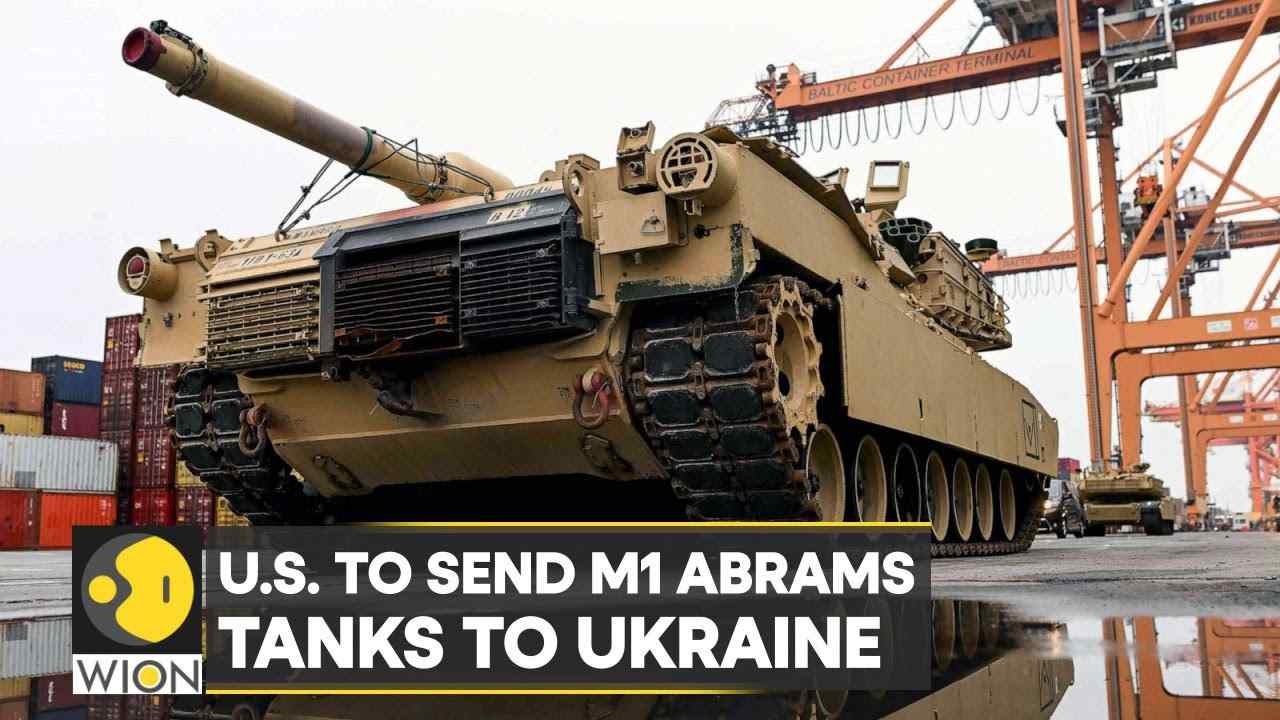
Written by Lucas Leiroz, journalist, researcher at the Center for Geostrategic Studies, geopolitical consultant
In yet another irresponsible step in the conflict, the US is about to send its first batch of Abrams tanks to Ukraine. The announcement shows how NATO remains willing to escalate its war against Russia and take it to the ultimate consequences. However, the real effects of the measure on the battlefield will be minimal, since there is no expectation of reversal in the military scenario.
The move was announced on August 1 by Doug Bush, the US Army Acquisition Chief, during an interview with CNN journalists. He stated that the first batch of Abrams tanks is now ready for delivery to Kiev. First, the vehicles will arrive in Europe and from there they will be sent to Ukraine, as well as all the necessary equipment for their use.
“They are done (…) Now they have to get to Europe, and then to Ukraine, along with all of the things that go with them. Ammunition, spare parts, fuel equipment, repair facilities. So you know, it’s not just the tanks, it’s the full package that goes with it. That’s still on track”, he said.
Currently, Ukrainian troops are being trained by NATO’s instructors to learn how to handle Abrams tanks. The ten-week training program will conclude at the end of August, with vehicles expected to arrive in September.
In fact, it is no surprise that these weapons are being sent, as promises in this regard have been made by the US government since January. However, apparently Ukrainian expectations are not being fully met. It was expected that 31 Abrams tanks would be sent to Kiev, but according to Politico the most likely is that only between six and eight vehicles will arrive in the country.
Not only the quantity, but also the quality of the tanks was diminished. The Pentagon had previously said it planned to help Ukraine with Abrams M1A2 tanks, however it changed its strategy in March, opting for the M1A1, which is an older model. Furthermore, it was recently reported by the Western media that the US is decreasing the M1A1’s capabilities by eliminating any technology deemed “sensitive” before delivering them to Kiev.
It was said by sources familiar with the topic that the tanks might “lose some of their most sophisticated electronics before seeing combat in Ukraine”. Among the equipment removed are artillery technology resources and depleted uranium armor. In practice, this shows that, although it is helping Ukraine, the US does not “trust” Kiev’s troops and tries to prevent them from “stealing” its military technology.
This reduction in the quality of the tanks makes it even more difficult for them to bring about any real change in the conflict. More likely, the arrival of the Abrams will have the same null effect on the battlefield as the US Bradleys and Germany’s Leopards.
For the Russians, the existence of a large number of enemy armored vehicles has little relevance, since Moscow’s defense lines are sufficiently fortified to neutralize Ukrainian advances with any type of tank. So, most likely the Abrams will also be easy targets for Russian artillery, air force and minefields.
Obviously, for the western media what actually matters is to spread the narrative that every new NATO weapon sent to Ukraine will be a “game changer”. Now, Western journalists are optimistic that the Abrams will help Kiev in the current “counteroffensive” by “breaking entrenched defenses”.
“The arrival of the tanks in the coming weeks will add a new, lethal dimension to Ukraine’s inventory as its forces struggle to break through entrenched Russian defenses along a front line that stretches for hundreds of miles”, Politico says.
However, from a realistic point of view, this is nothing more than unsubstantiated propaganda. The Ukrainian counteroffensive cannot go from absolute failure to sudden victory with the mere arrival of a new tank, simply because tanks do not win wars alone. The technical apparatus of a country at war is important, but it is just one of the factors involved in a military campaign. There are also many other points to be considered, such as strategic planning, tactical-operational strength, troops’ morale and capacity to replace losses. In all these sectors Ukraine has serious weaknesses, despite receiving Western weapons systematically. And it is for this reason that the “counteroffensive” tends to fail regardless of any foreign help.
The only thing new weapons can do to conflict is escalate and prolong it. The more Western equipment arrives in Ukraine, the longer the fighting will last, and the more incisive Russian military measures will have to be in order to neutralize the enemy side. In other words, in addition to not being able to reverse the military scenario of the conflict in favor of its proxy, NATO is simply unnecessarily increasing the suffering of the Ukrainian people.
https://southfront.org/abrams-tanks-not ... r-ukraine/
